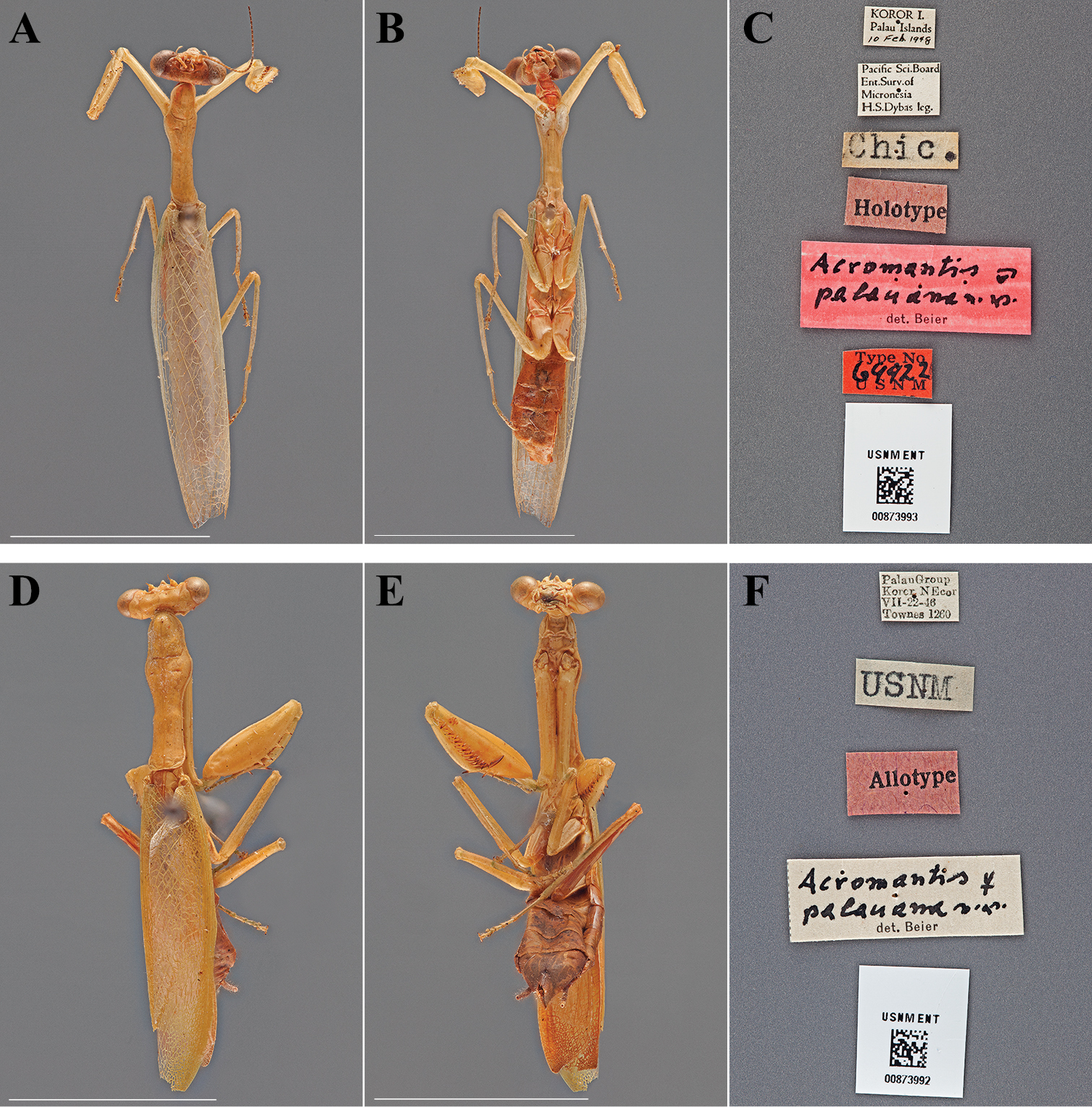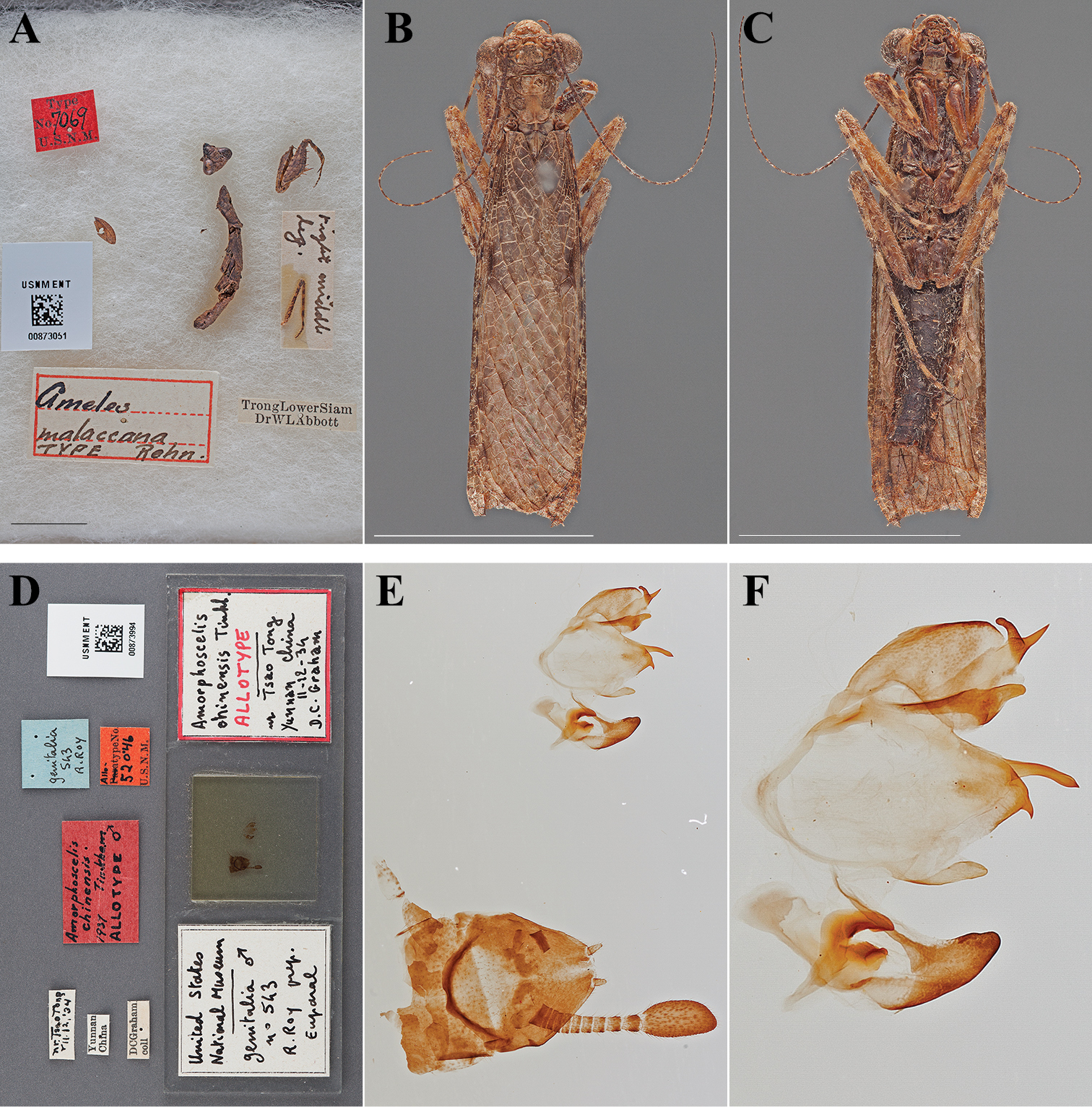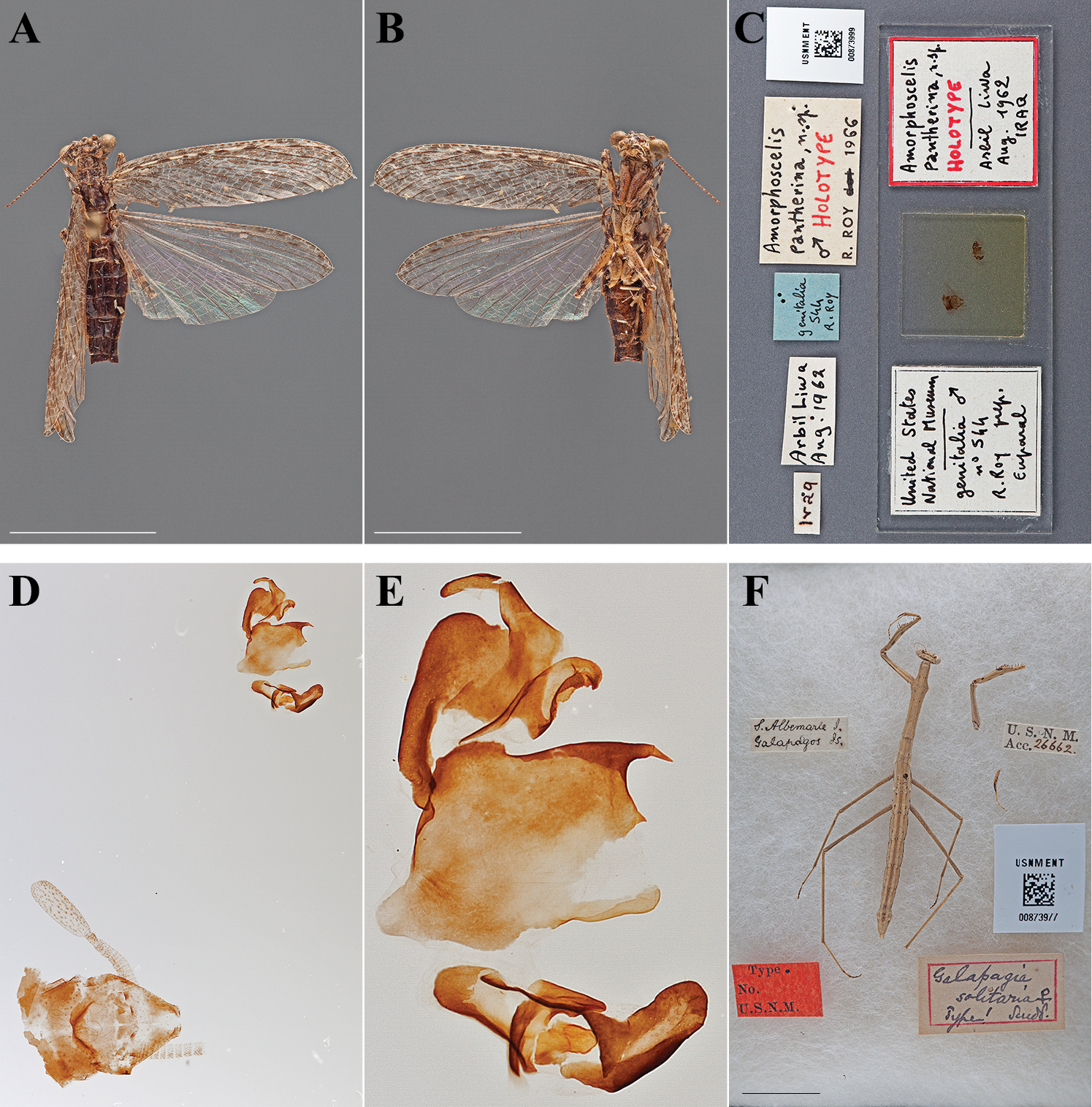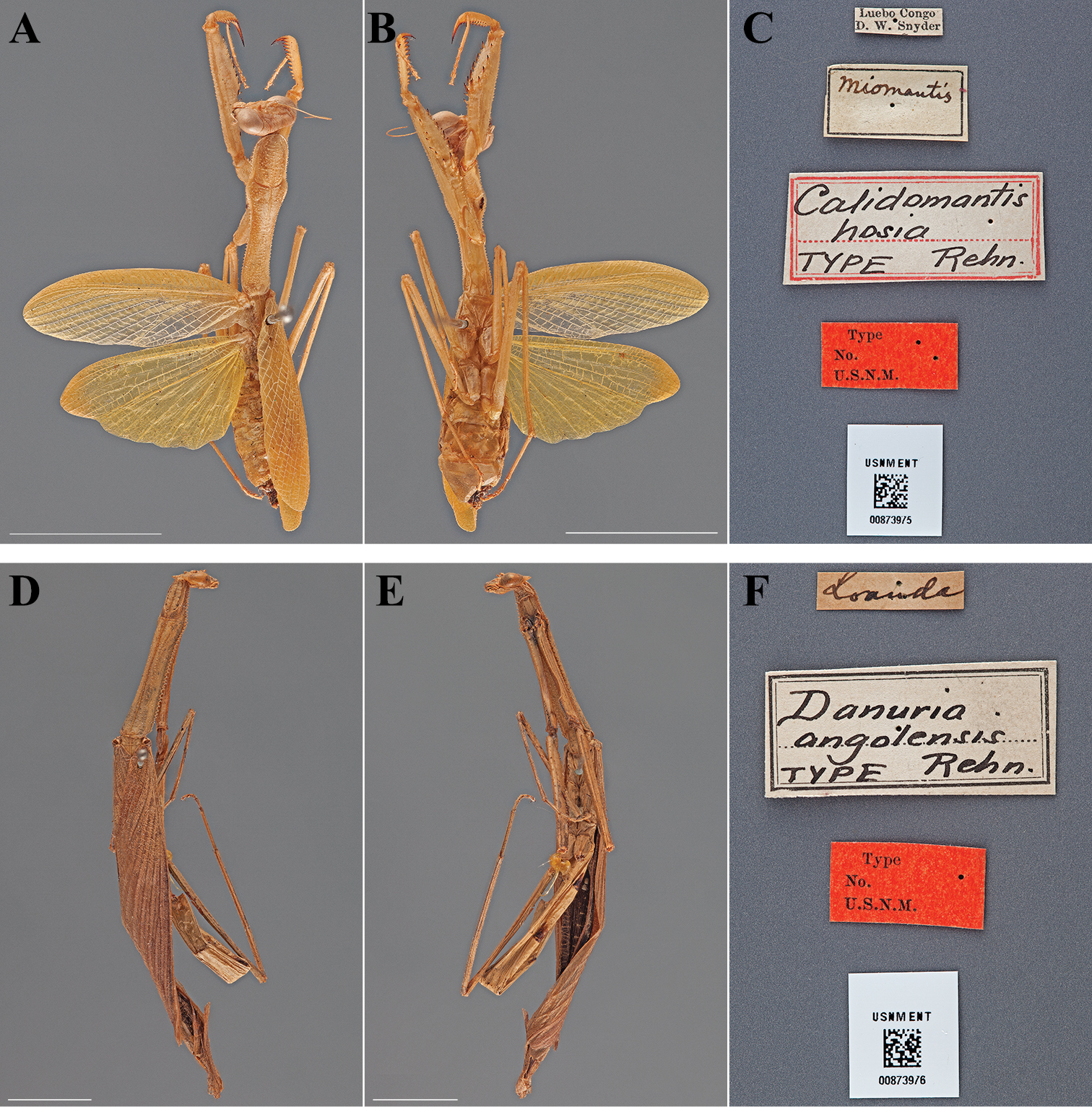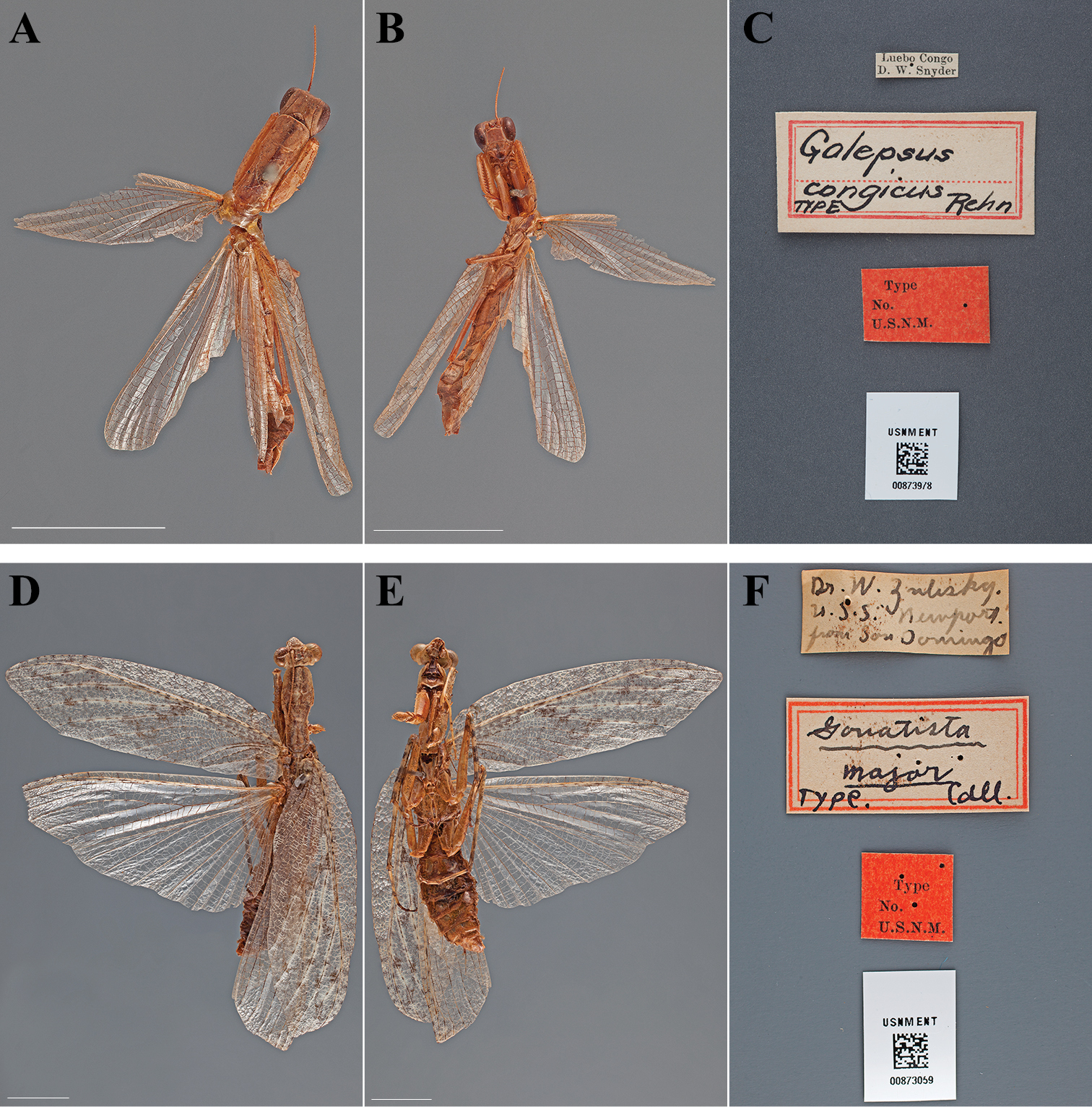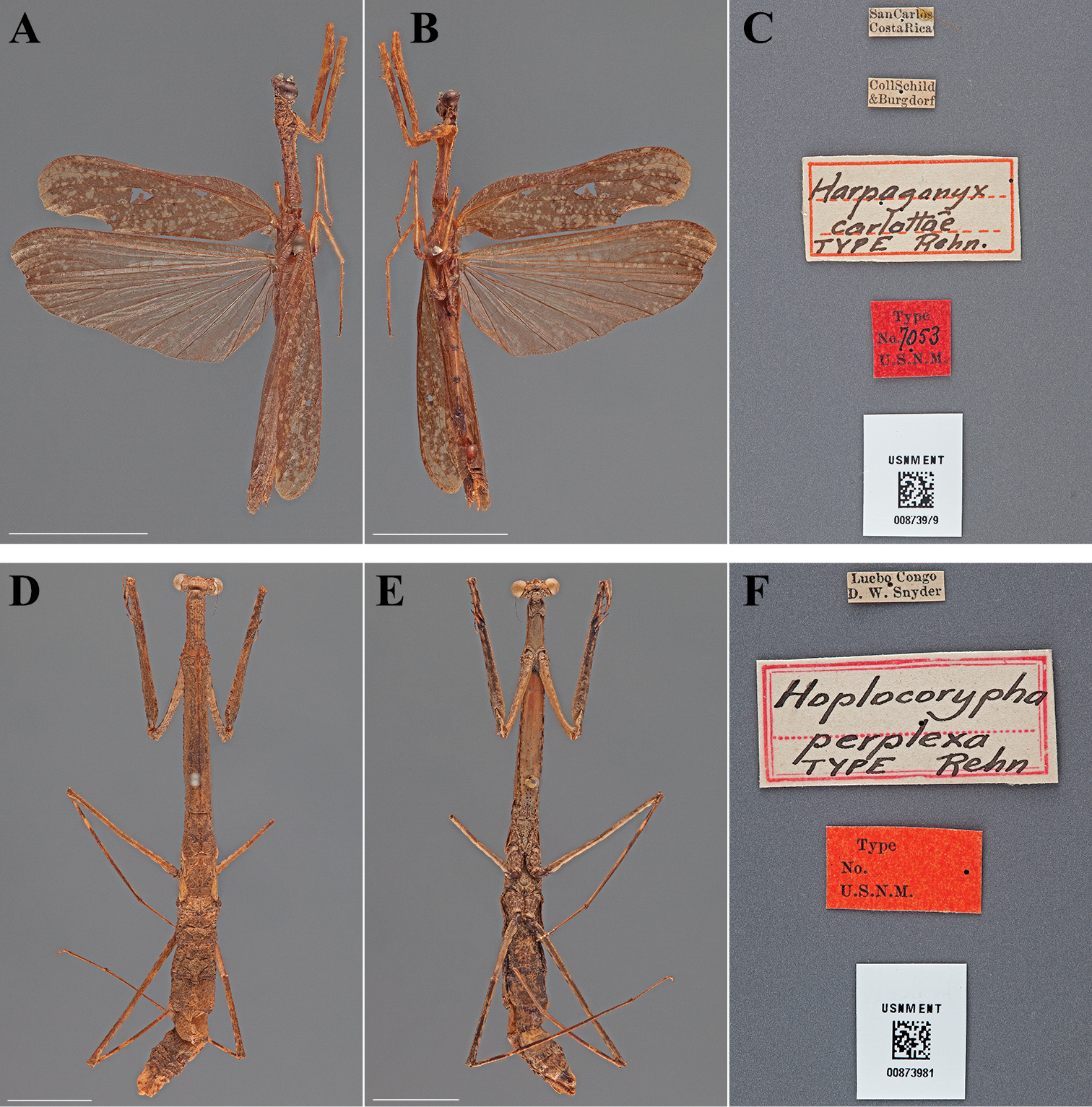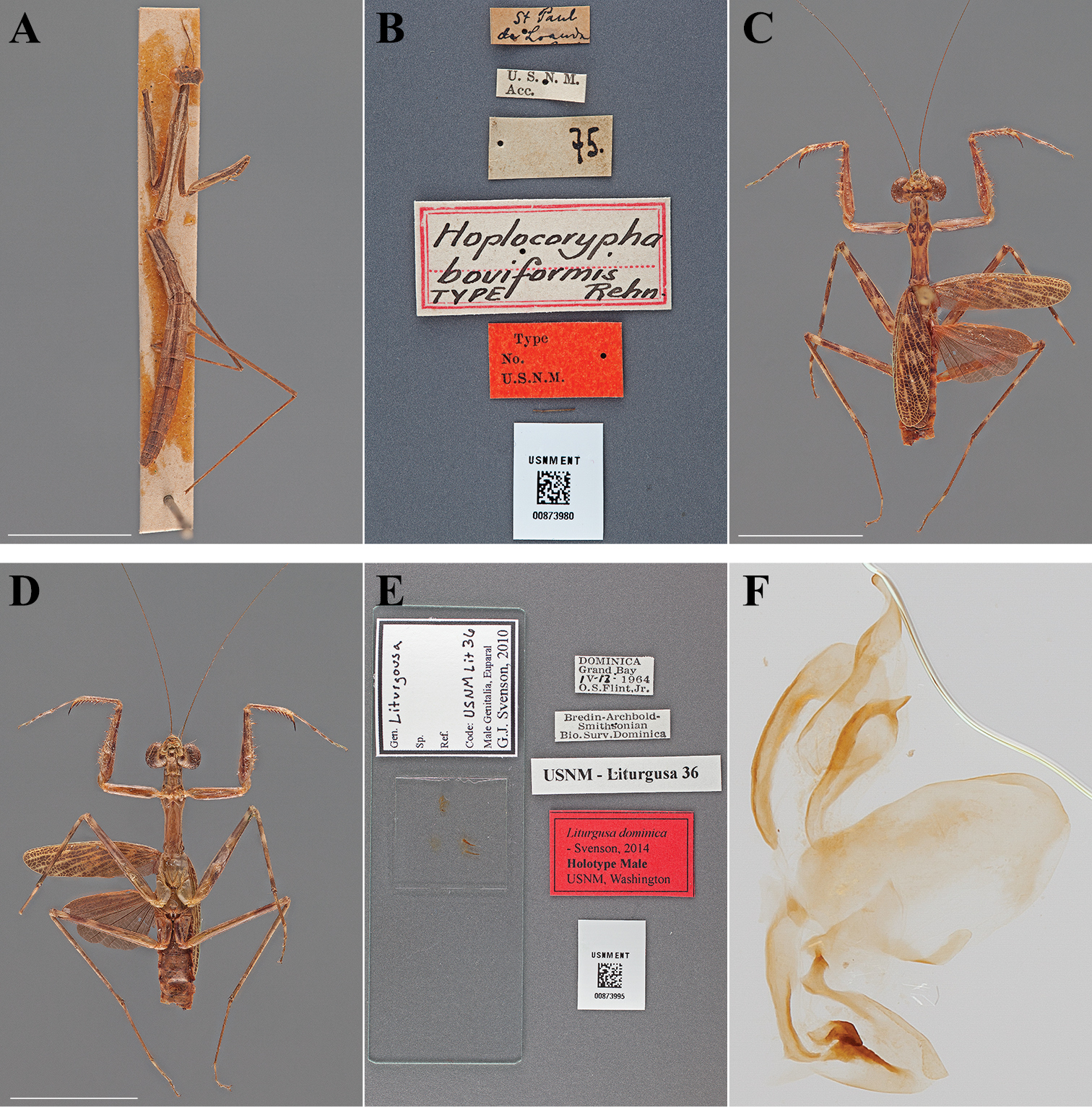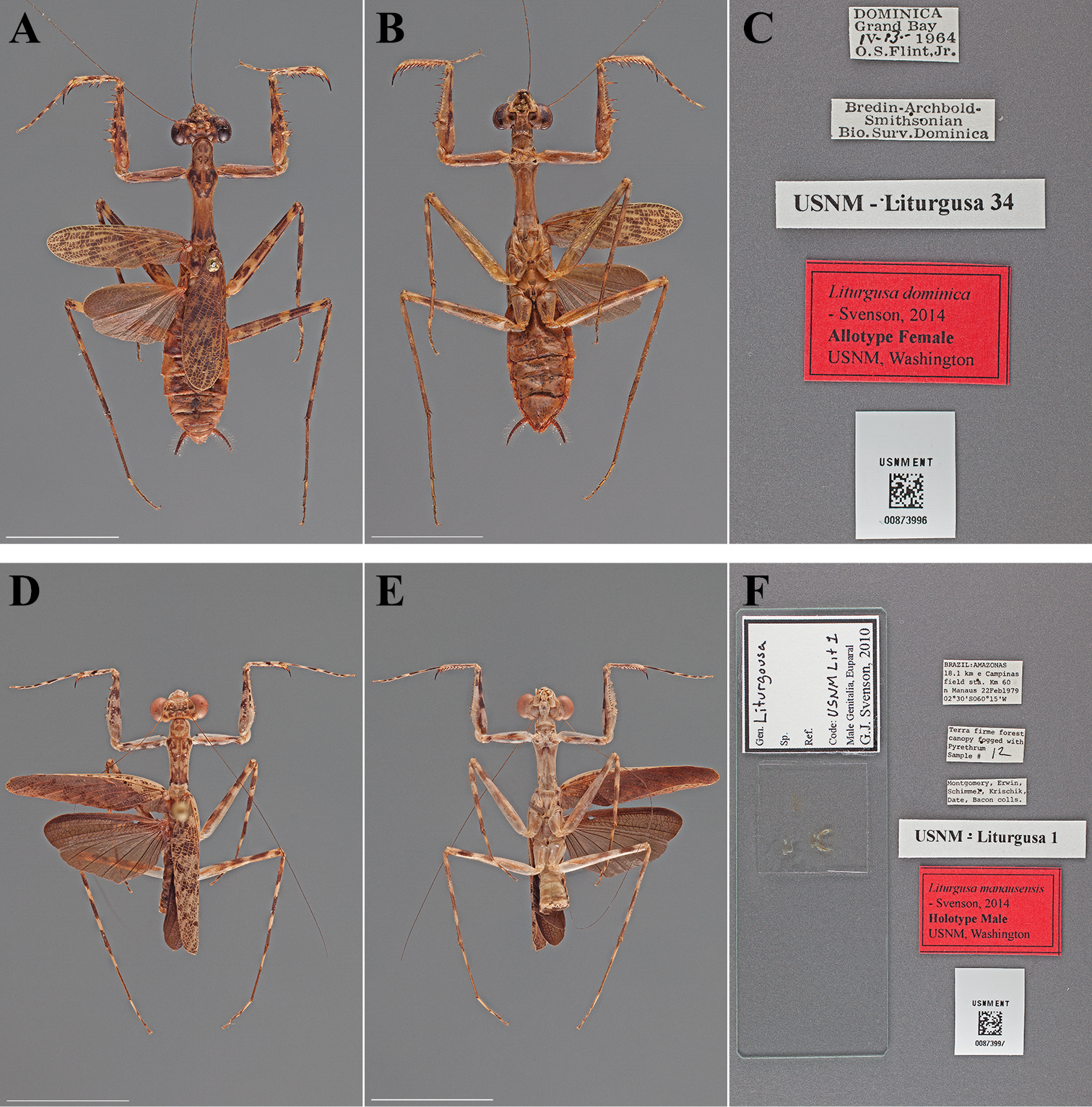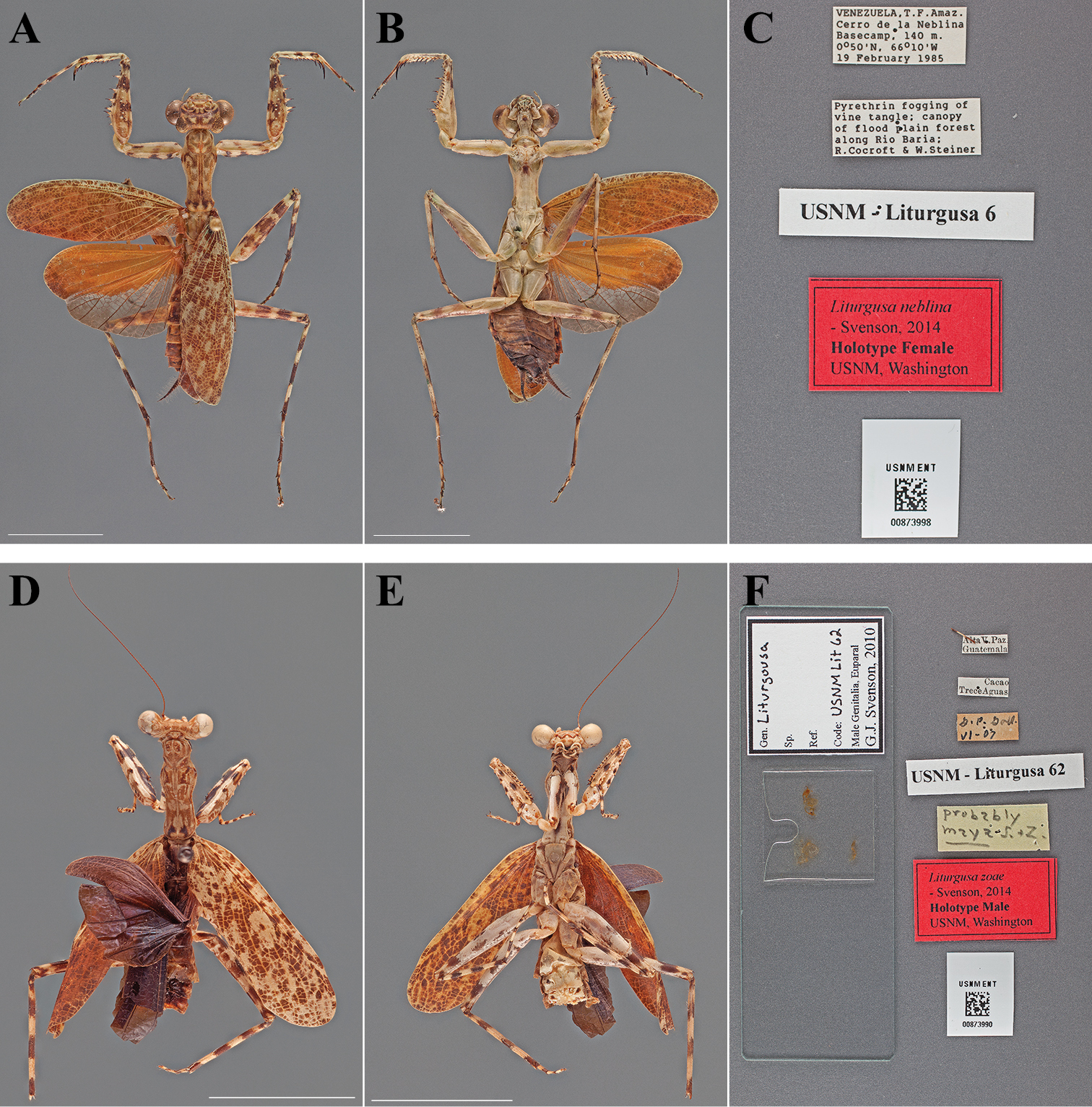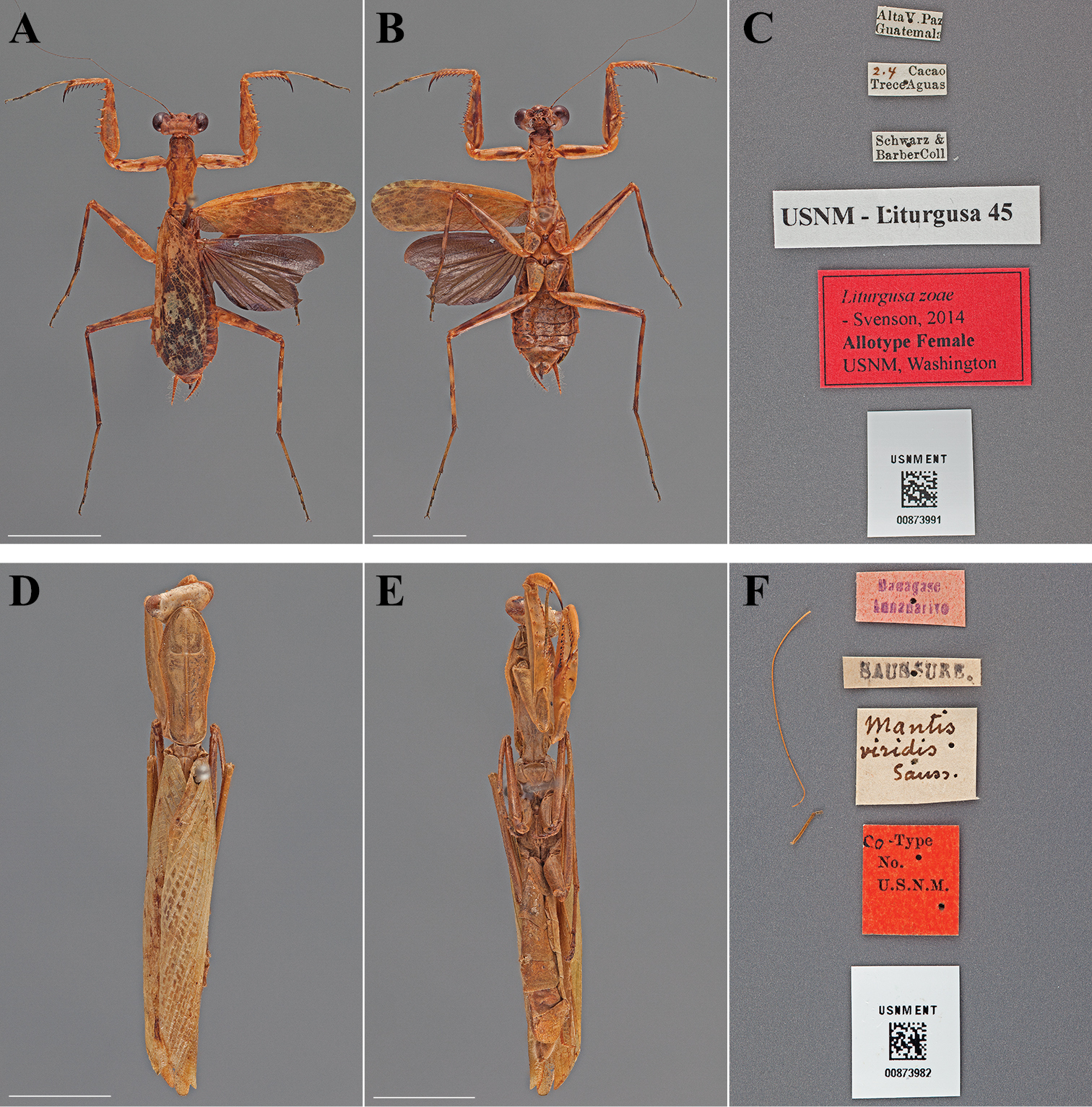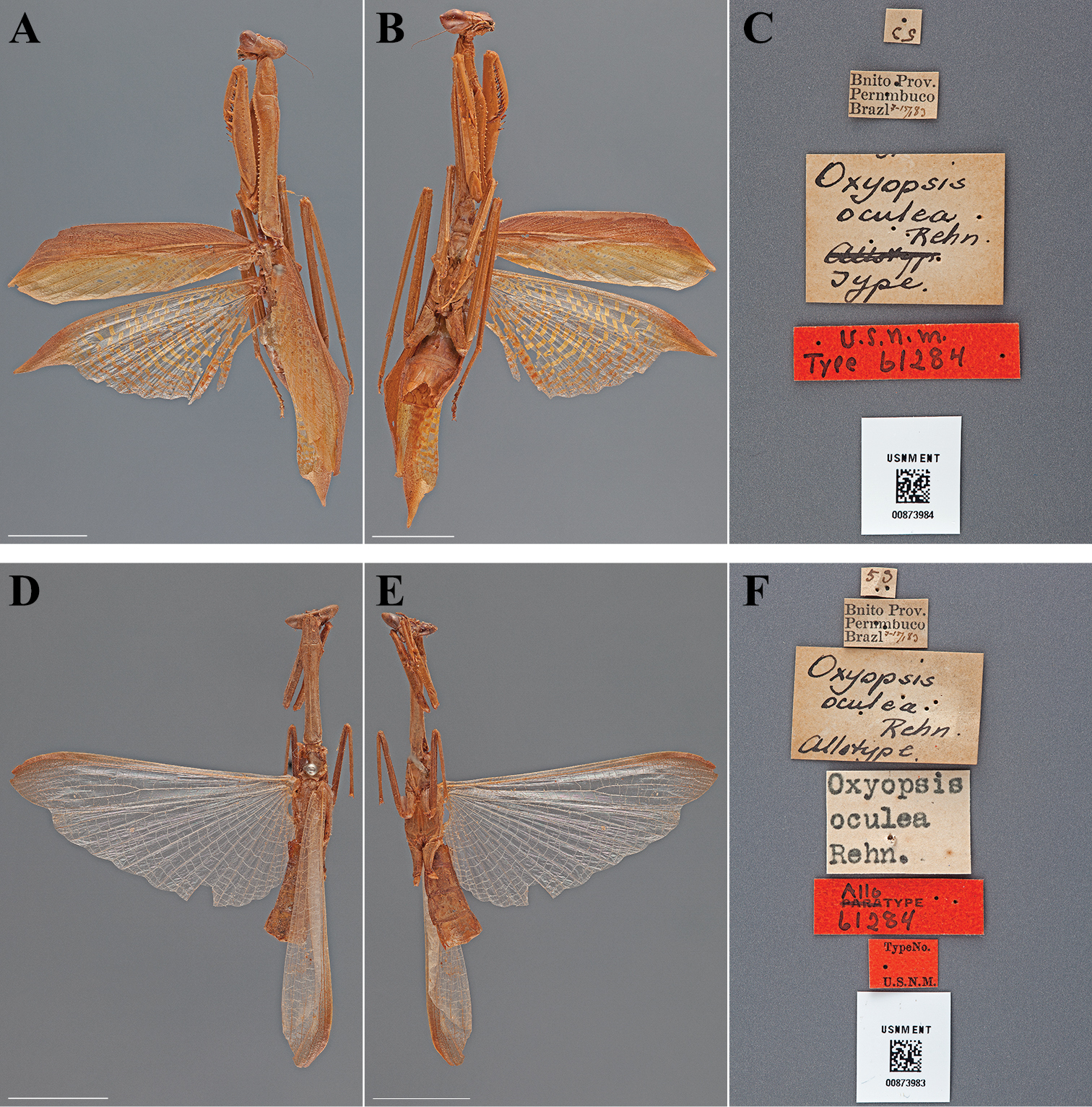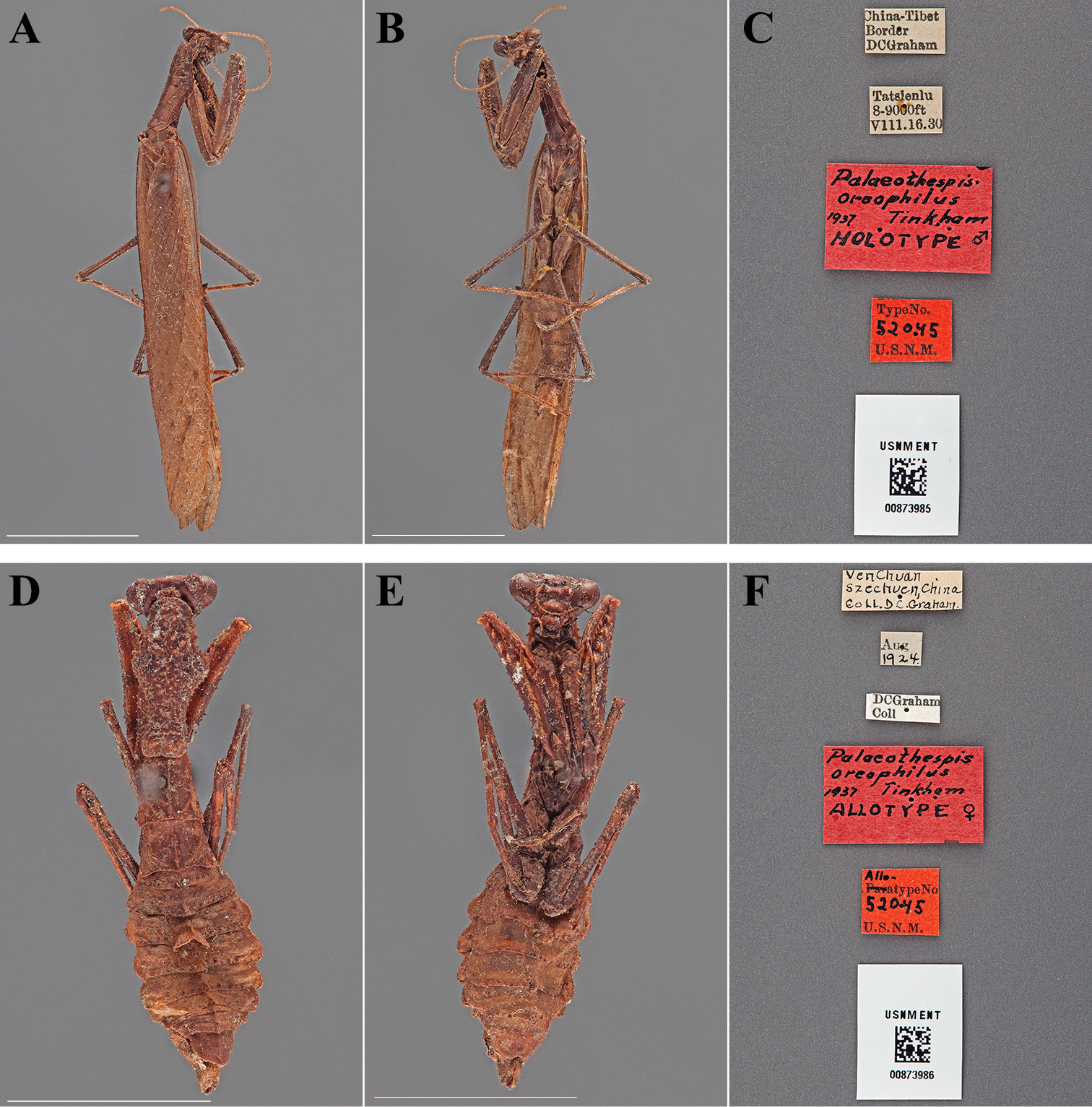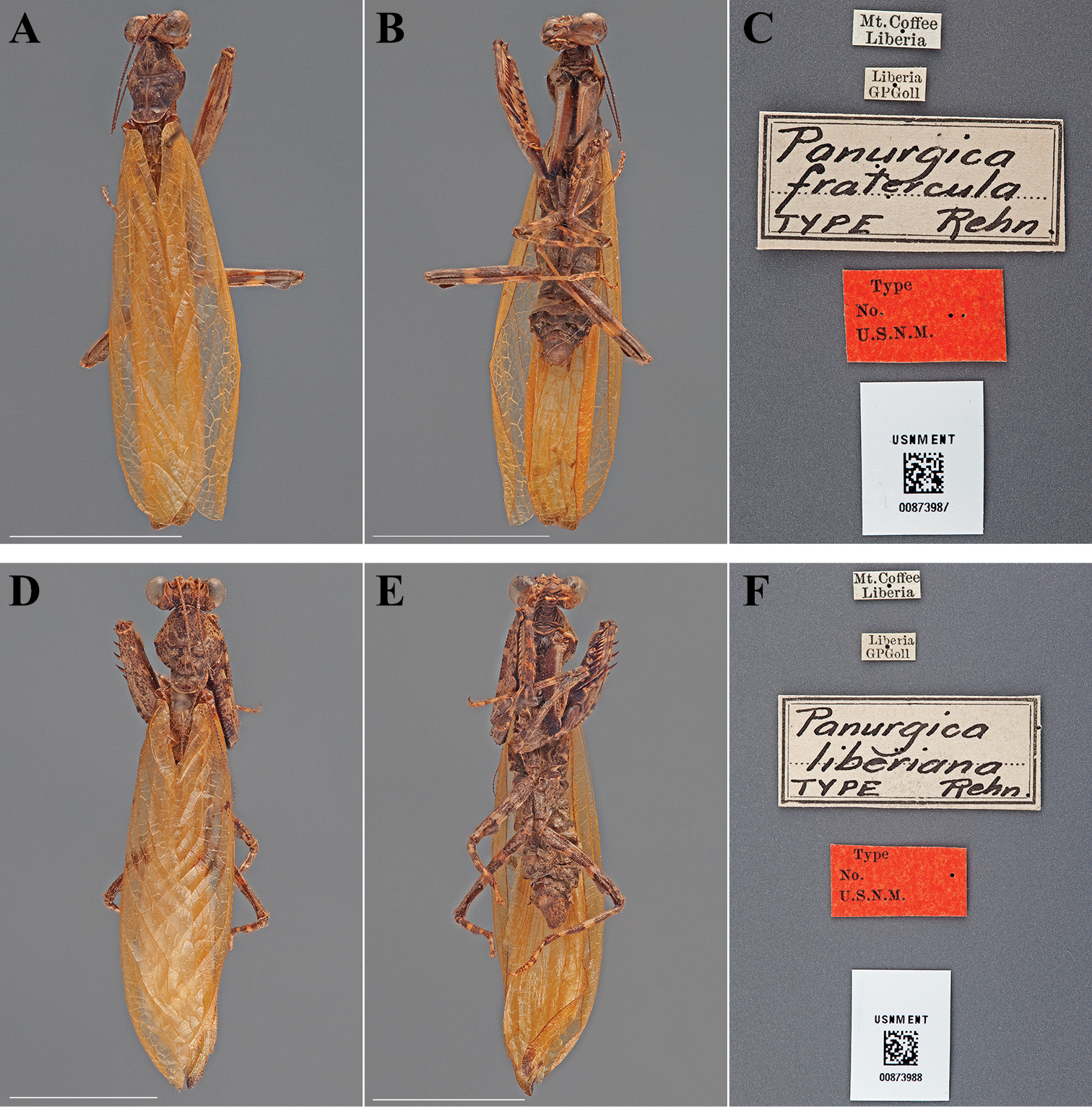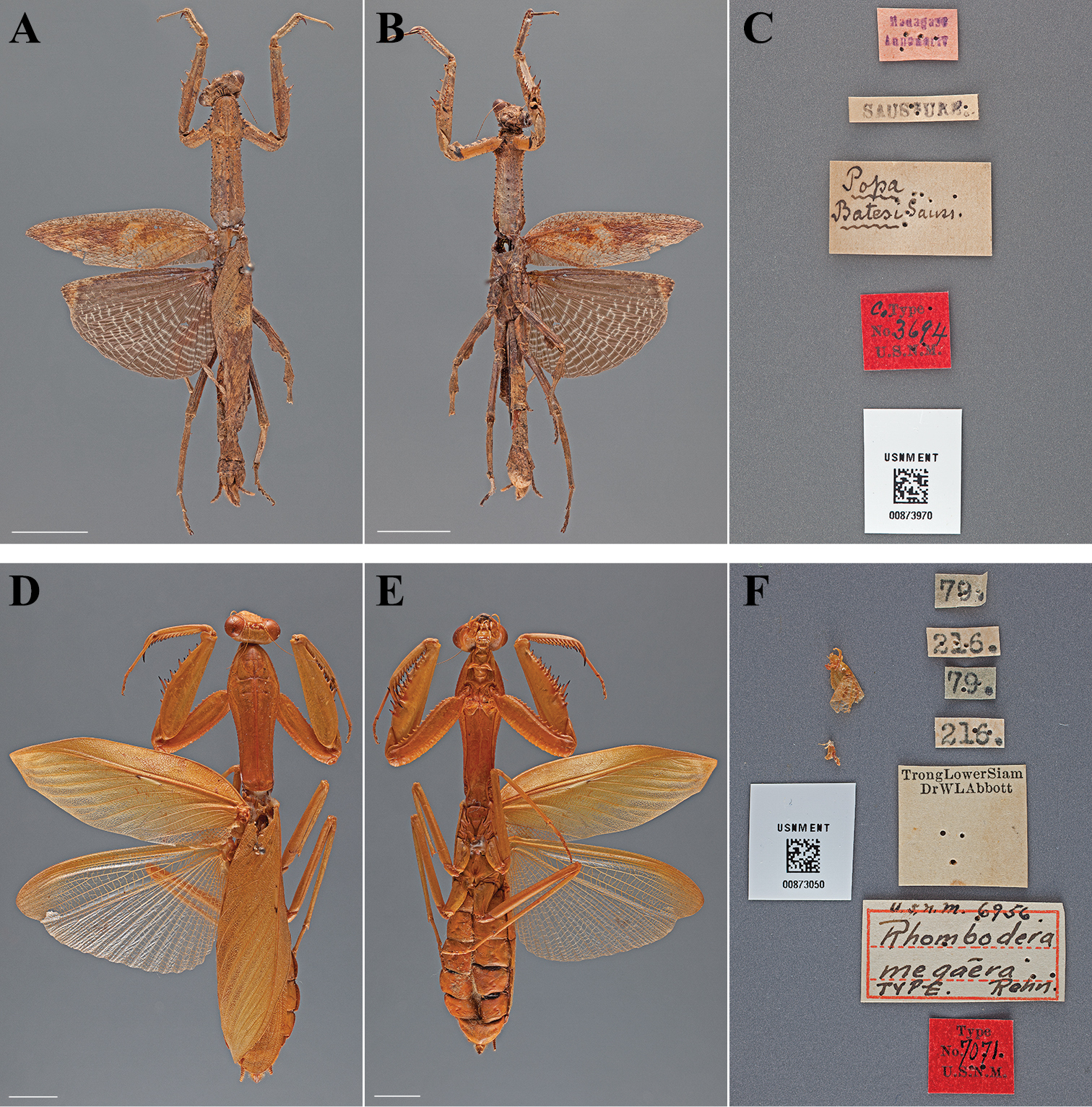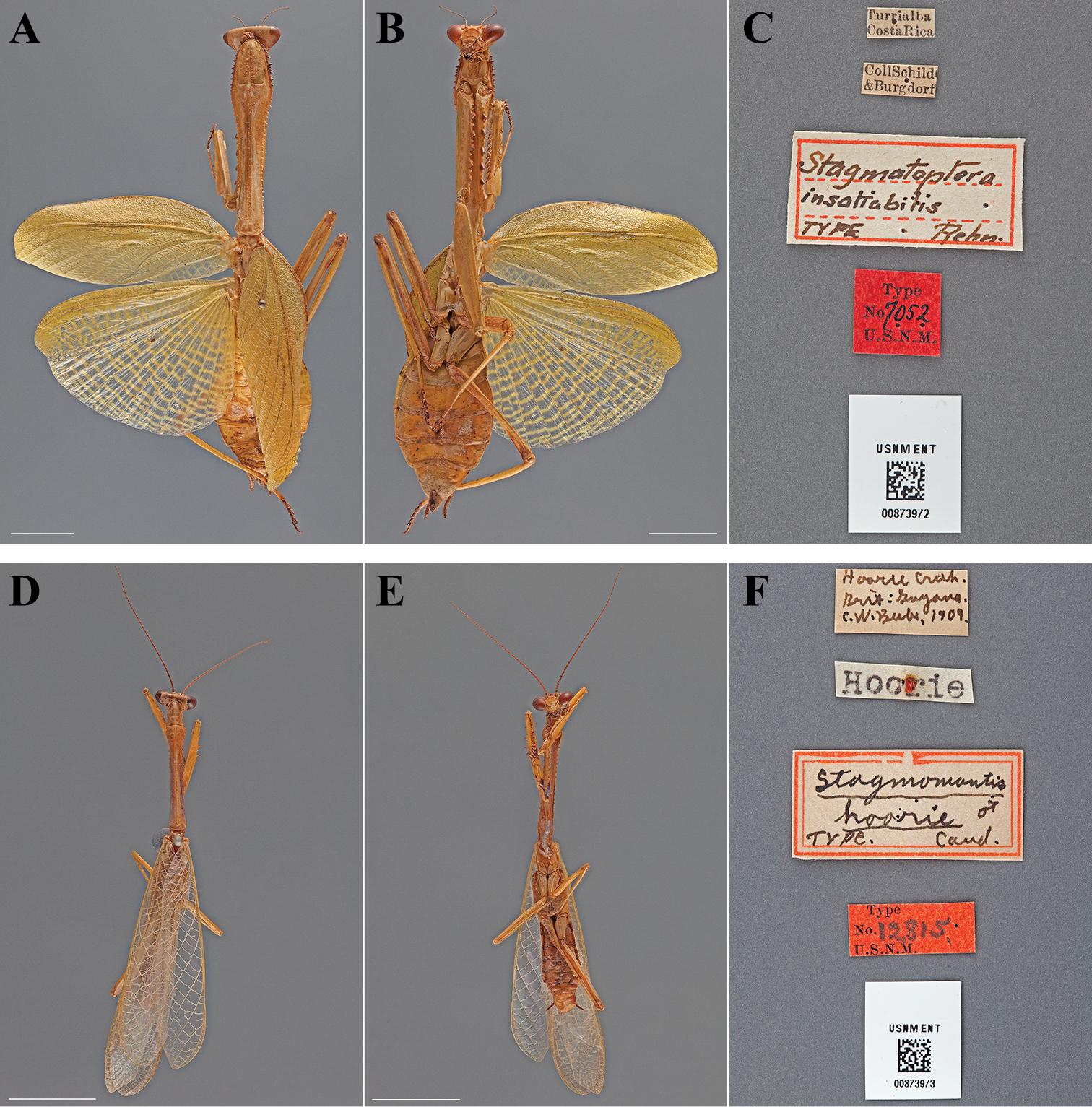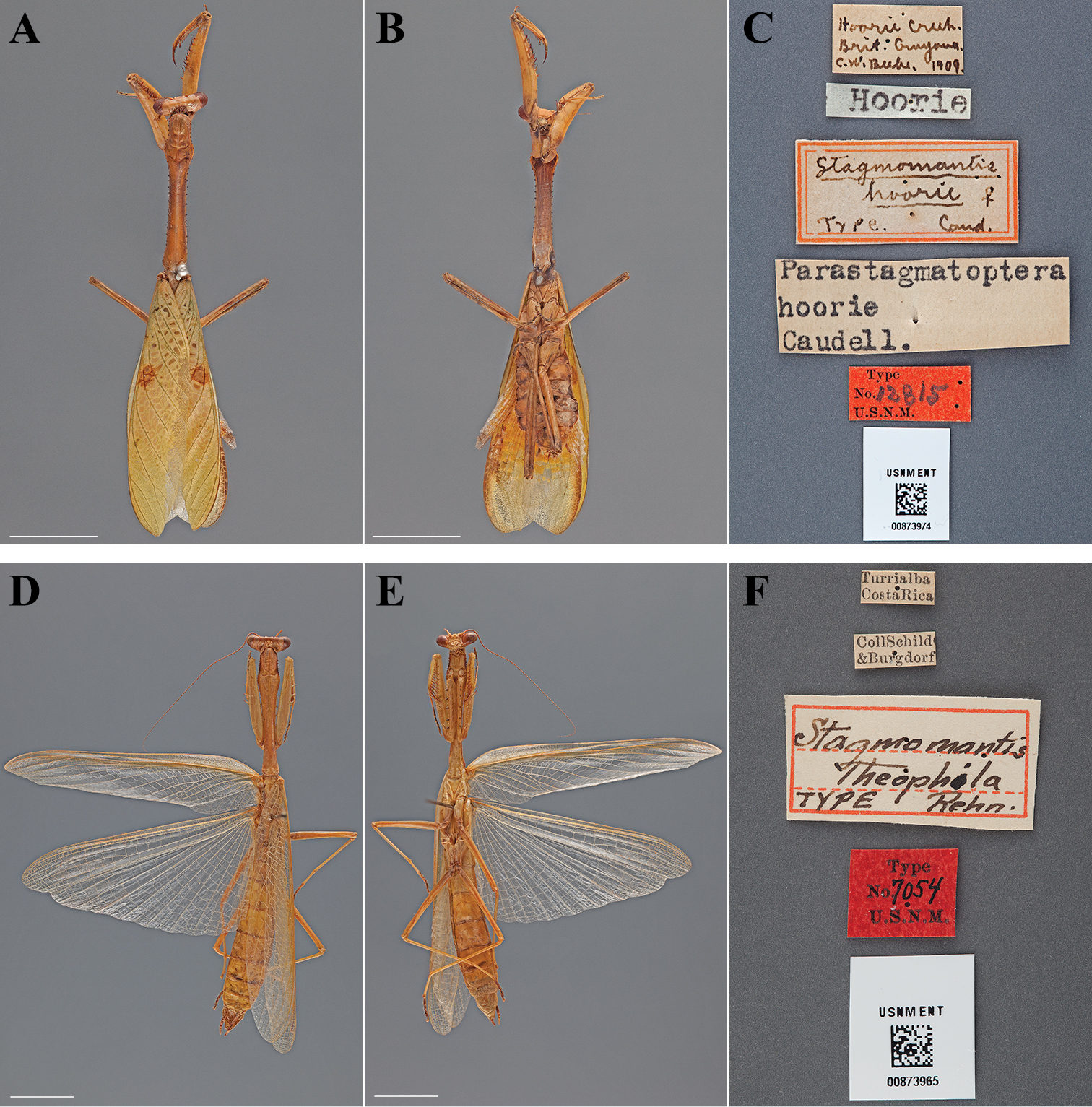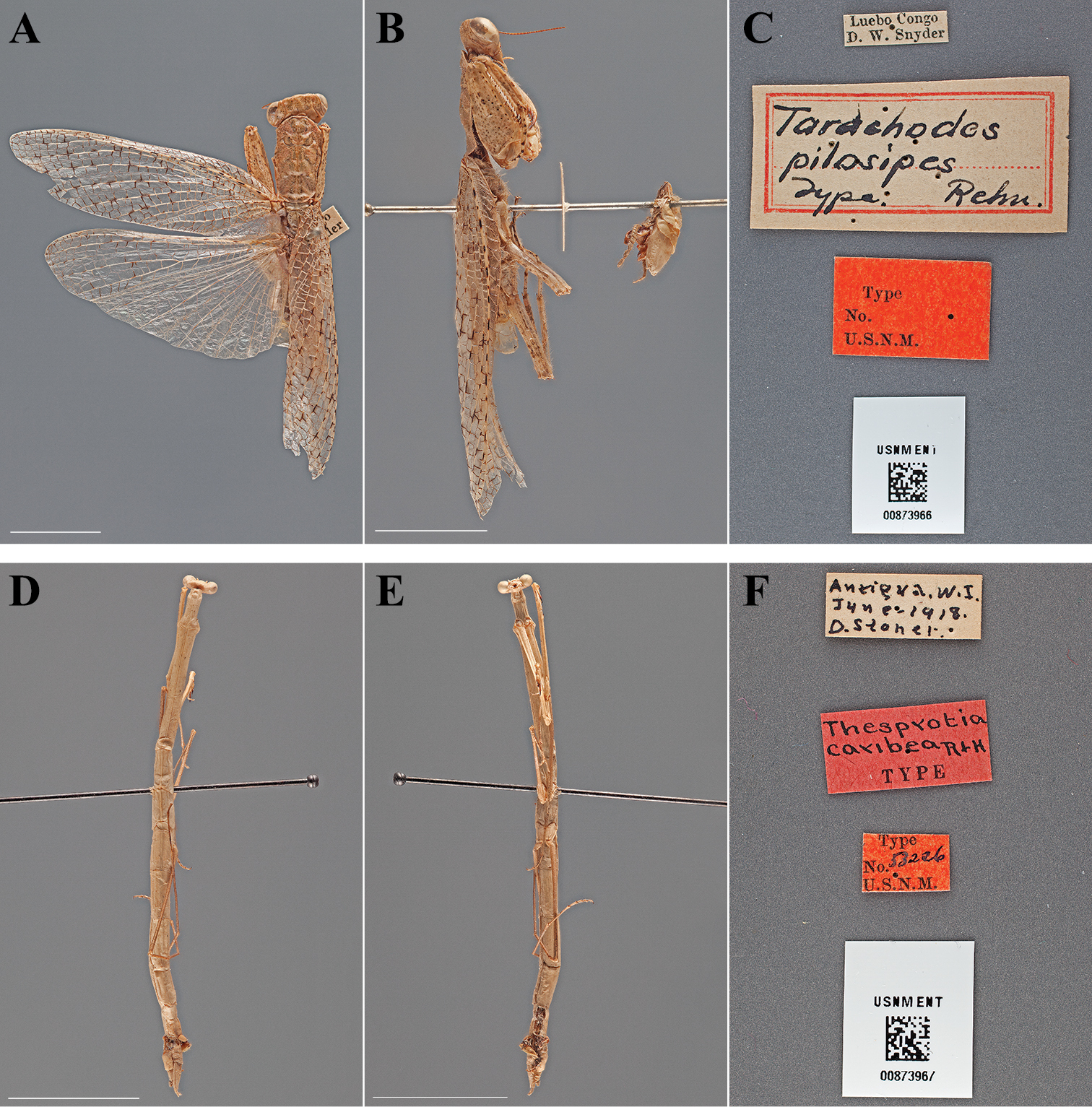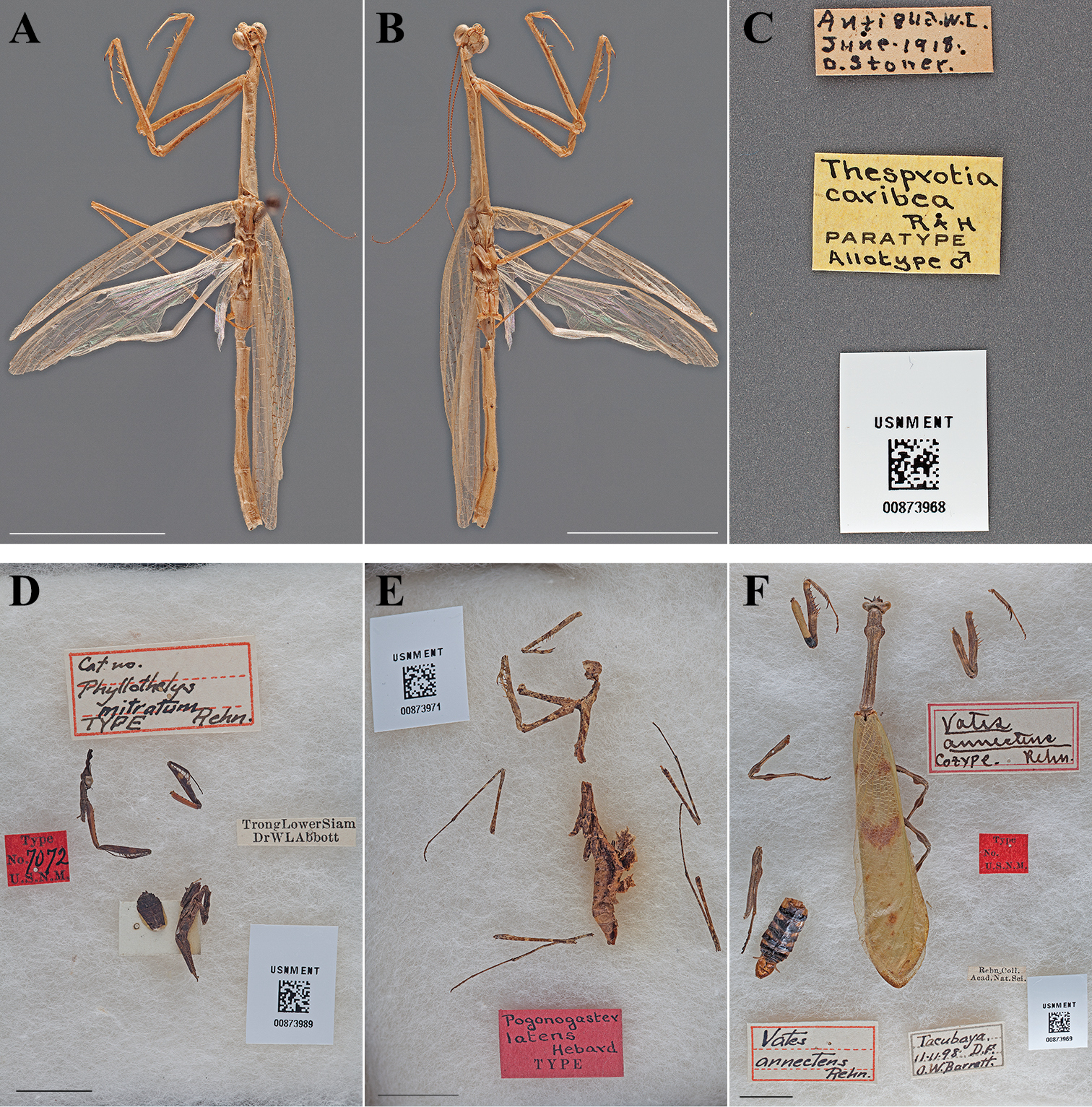






Citation: Svenson GJ (2014) The type material of Mantodea (praying mantises) deposited in the National Museum of Natural History, Smithsonian Institution, USA. ZooKeys 433: 31–75. doi: 10.3897/zookeys.433.7054
The collection of Mantodea of the National Museum of Natural History, Smithsonian Institution, includes 26 holotypes, 7 allotypes, 4 lectotypes, 23 paratypes, and 1 paralectotype. Four type specimens were designated as lectotypes within this work. Highly accurate measurement data, high resolution images of specimens and labels, verbatim label data, georeferenced coordinates, original and newly assigned database codes, and bibliographic data are presented for all primary types. Label data for all paratype specimens in the collection are provide in tabular form. The location of the USNM collection has been moved to the Cleveland Museum of Natural History as a loan under the Off-site Enhancement Program.
Taxonomy, Mantodea, praying mantis, holotype, allotype, paratype, lectotype, classification
The collection of Mantodea of the National Museum of Natural History, Smithsonian Institution, includes 26 holotypes, 7 allotypes, 4 lectotypes, 23 paratypes, and 1 paralectotype. The primary type material is mostly from the Afrotropical or Indomalayan regions (62%) while the remaining species are Neotropical. The paratypes largely stem from the revision of Liturgusa, which is a Neotropical group (
The four species with types considered as syntype material based on the original description were investigated with a literature search. It was found that they lacked a designated holotype or an indication of a sole name-bearing specimen, but rather a group of types, cotypes, or syntypes (see Article 73.2 of the International Code of Zoological Nomenclature, 4th Edition [the Code]). In addition, there was no record of a lectotype designation previous to the current work. Consequently, under Article 74.1 of the Code, lectotypes were designated for Galapagia solitaria Scudder, 1893, Popa batesi Saussure & Zehntner, 1895, Stagmomantis hoorie Caudell, 1910, and Vates annectens Rehn, 1900, from syntypes held within the collection of the National Museum of Natural History, Smithsonian Institution to increase taxonomic stability and reduce confusion by creating sole name-bearing specimens for the species above.
In 2012, the collection of Mantodea of the National Museum of Natural History was relocated from Washington, D.C. to the Cleveland Museum of Natural History in Cleveland, Ohio. The collection and the type material are on loan to GJ Svenson under the Off-site Enhancement Program. Svenson oversees curation of the collection and the management of loans related to the collection. All inquiries, loan requests, and visits should be directed to GJ Svenson at the above listed email address.
This paper aims to provide label data, images, georeferenced coordinates, measurements, and references for type material. In addition, this paper aims to resolve confusion regarding the repository of many of these types, which have been incorrectly listed in previous works (see below) as being located in the Academy of Natural Sciences, Philadelphia, the Bernice Pauahi Bishop Museum, Honolulu, the California Academy of Sciences, San Francisco, the Museum of Comparative Zoology, Harvard University, Cambridge, and the Museum für Naturkunde der Humboldt-Universität, Berlin.
Specimen data: A bibliography for each type was compiled to track use of the species binomen in the taxonomic literature since the original description. The type classification or designation of lectotype is presented followed by all label data directly transcribed using “–” to indicate a line break within a label and “/” to indicate a label break between labels. Codes from the USNM (National Museum of Natural History) were assigned to most of the type material and placed on the specimens, but in some cases these codes are incongruent with those presented in the original descriptions. A possible explanation may be that the codes in the original descriptions were not placed on the specimens. Subsequently, an effort to assign specimen codes across the collection or type collection resulted in the incongruities. Currently, all specimens at the USNM are being labeled with scannable collection codes for databasing, which are reported here as an eight digit numerical code following USNM ENT (National Museum of Natural History, Department of Entomology).
Georeferencing: All locality data for type specimens was collected from the primary literature as well as directly transcribed off the labels attached to the specimen. A table is included that contains the type designation, the specimen sex, revised location data that may include additional details not include on the labels sourced from the literature, and georeferenced GPS coordinates in decimal degrees.
Measurements: Each type specimen was measured using a Leica M165C stereo-microscope and an IC80 HD coaxial video camera using the live measurements module of the Leica Application Suite (LAS v4.2). Measurements captured in this study are extremely precise using this digital system, which provides a high level of accuracy to users wishing to compare types with other specimens in their study. All measurements presented in this study are in millimeters. A total of 23 measurement classes were captured and defined as:
-
Body length = length of body from central ocelli to posterior tip of wing or abdomen (intraspecifically variable measurement, primarily for general size estimation).
-
Forewing length = from proximal margin of axillary sclerites to distal tip of the discoidal region.
-
Hindwing length = from proximal margin of axillary sclerites to distal tip of the discoidal region.
-
Pronotum length = from anterior margin to posterior margin.
-
Prozone length = anterior margin of pronotum to center of supra-coxal sulcus.
-
Pronotum width = from lateral margins at the widest point including any lamellar expansions, the supra-coxal bulge.
-
Pronotum narrow width = from lateral margins of the pronotum at narrowest region of metazone.
-
Head width = from lateral margins of the eyes at widest point.
-
Head vertex to clypeus = from the vertex of the head at center to the lower margin of the frons and upper margin of clypeus.
-
Frons width = from lateral margins of frons, inferior to the antennal insertions, at the widest point.
-
Frons height = from upper margin abutting central ocellus to lower margin abutting clypeus.
-
Prothoracic femur length = from proximal margin abutting trochanter to distal margin of genicular lobe.
-
Mesothoracic femur length = from most proximal margin abutting trochanter to the distal side of the terminal spine insertion site.
-
Mesothoracic tibia length = from most proximal groove near joint with the femur to the distal side of the terminal spine insertion site.
-
Mesothoracic tarsus length = from proximal joint to the apex of the ungues curve.
-
Metathoracic femur length = from most proximal margin abutting trochanter to the distal side of the terminal spine insertion site.
-
Metathoracic tibia length = from most proximal groove near joint with the femur to the distal side of the terminal spine insertion site.
-
Metathoracic tarsus length = from proximal joint to the apex of the ungues curve.
-
Discoidal femoral spine count = all centrally position spines between anteroventral and posteroventral femoral spines (Right/Left).
-
Anteroventral femoral spine count = all inner marginal ridge spines and two proximal near marginal spines, but excluding the genicular spine (Right/Left).
-
Posteroventral femoral spine count = all outer marginal ridge spines, but excluding the genicular spine (Right/Left).
-
Anteroventral tibial spine count = all inner marginal ridge spines, but excluding the distal terminal spur (Right/Left).
-
Posteroventral tibial spine count = all outer marginal ridge spines, but excluding the distal terminal spur (Right/Left).
Imaging: High resolution images of type specimens were captured using a Passport Storm© system (Visionary Digital™, 2012), which includes a Stackshot z-stepper, a Canon 5D SLR, macro lenses (50mm, 100mm, and MP-E 65mm), three Speedlight 580EX II flash units, and an associated computer running Canon utility and Adobe Lightroom 3.6 software. The z-stepper was controlled through Zerene Stacker 1.04 and images were processed using the P-Max protocol. All images were captured over an 18% grey card background for white balance standards. Images were processed in Adobe Photoshop CS6 Extended to adjust levels, contrast, exposure, sharpness, and add scale bars (10 mm). Minor adjustments were made using the stamp tool to correct background aberrations and to remove distracting debris. Plates were constructed using Adobe Illustrator CS6. Dorsal, ventral and sometimes lateral habitus images were captured depending on specimen mount position and visibility of important features. Images of all labels were captured as well as slide mounted genitalia when available.
Additionally, images were batch processed with Bigshot 2.0 (https://code.google.com/p/bigshot/) to create zoomable image pyramids in HTML5 for deposition on the Project Mantodea server for public access through the project website (found at: http://specimens.mantodearesearch.com under Type specimens).
ANSP Academy of Natural Sciences of Drexel University, Philadelphia, PA, USA
BPBM Bernice Pauahi Bishop Museum, Honolulu, Hawai’i, USA
CAS California Academy of Sciences, San Francisco, CA, USA
MCZ Museum of Comparative Zoology, Harvard University, Cambridge, MA, USA
USNM National Museum of Natural History, Smithsonian Institution, Washington, DC, USA
ZMHB Museum für Naturkunde der Humboldt-Universität, Berlin, Germany
Holotype Male (Fig. 1A–C; USNM ENT 00873993). Allotype Female (Fig. 1D–F; USNM ENT 00873992).
Acromantis palauana Beier, 1972 (scale bars = 1 cm). Holotype male (USNM ENT 00873993): A dorsal habitus B ventral habitus C labels. Allotype female (USNM ENT 00873992): D dorsal habitus E ventral habitus F labels.
Koro I. – Palau Islands – 10 Feb. 1948 / Pacific Sci.Board – Ent. Surv. of – Micronesia – H.S.Dybas leg. / Chic. / Holotype / Acromantis – palauana n.sp. – det. Beier / Type No 69422 USNM.
Palau Group – Koror NEcor – VII-22-46 – Townes 1260 / USNM / Allotype.
| Holotype | Male | Palau Islands, Koror | 10 Feb 1948 | 7.341023, 134.478913 | |
| Allotype | Female | Palau Islands, Koror | 22 Jul 1946 | 7.341023, 134.478913 | |
Holotype male. Body length 23.05; forewing length 15.85; pronotum length 6.05; prozone length 1.80; pronotum width 1.87; pronotum narrow width 1.11; head width 3.83; head vertex to clypeus 1.39; frons width 1.34; frons height 0.42; prothoracic femur length 5.35; mesothoracic femur length 4.22; mesothoracic tibia length 3.25; mesothoracic tarsus length 2.71; metathoracic femur length 4.57; metathoracic tibia length 4.75; metathoracic tarsus length 3.33; discoidal femoral spines R4/L4; anteroventral femoral spine count R13/L13; posteroventral femoral spine count R4/L4; anteroventral tibial spine count R12/L13; posteroventral tibial spine count R12/L11.
Allotype female. Body length 24.81; forewing length 14.56; hindwing length 12.46; pronotum length 7.67; prozone length 2.30; pronotum width 2.34; pronotum narrow width 1.41; head width 4.50; head vertex to clypeus 1.79; frons width 1.62; frons height 0.64; prothoracic femur length 6.94; mesothoracic femur length 4.82; mesothoracic tibia length 3.66; mesothoracic tarsus length 2.69; metathoracic femur length 4.14; metathoracic tibia length 5.87; metathoracic tarsus length 3.73; discoidal femoral spines R4/L4; anteroventral femoral spine count R13/L13; posteroventral femoral spine count R4/L4; anteroventral tibial spine count R12/L12; posteroventral tibial spine count R11/L11.
Holotype Female (Fig. 2A; USNM ENT 00873051). The female specimen was referred to as the “Type” by
Types (scale bars = 1 cm). Ameles malaccana Rehn, 1903 holotype female (USNM ENT 00873051): A dorsal habitus and labels in Riker mount. Amorphoscelis chinensis Tinkham, 1937 allotype male (USNM ENT 00873994): B dorsal habitus C ventral habitus D labels and genitalic slide mount E genital complex and terminal abdominal segments F gential complex.
Trong Lower Siam – Dr WL Abbott / right medial leg. / Ameles – malaccana – TYPE Rehn. / Type – No. 7069 – U.S.N.M. [Cat. No. 6955 USNM; referenced in the original description]
| Holotype | Female | Thailand, Trang | date unknown | 7.596958, 99.725938 | |
Body length 22.41; forewing length 4.62; hindwing length 2.54; pronotum length 6.08; prozone length 2.57; pronotum width 3.23; pronotum narrow width 2.21; head width 4.62; head vertex to clypeus 1.69; frons width 1.39; frons height 0.93; prothoracic femur length 6.73; mesothoracic femur length 5.90; mesothoracic tibia length 4.71; mesothoracic tarsus length 3.29; anteroventral femoral spine count R13; posteroventral femoral spine count R4; anteroventral tibial spine count R9; posteroventral tibial spine count R10.
Allotype Male (Fig. 2B–F; USNM ENT 00873994).
nr. Tsao Tong – VII.12, ‘34 / Yunnan – China / DCGraham – coll / Amorphoscelis – chinensis – 1937 Tinkham – ALLOTYPE ♂ / genitalia – 543 – R.Roy / Allotype No. – 52046 – U.S.N.M.
| Allotype | Male | China, Yunnan, Zhaotong | 12 Jul 1934 | 27.382511, 103.804815 | |
Body length 21.88; forewing length 18.00; pronotum length 2.18; prozone length 0.88; pronotum width 2.64; pronotum narrow width 2.34; head width 4.79; head vertex to clypeus 1.86; frons width 2.04; frons height 0.39; prothoracic femur length 3.63; mesothoracic femur length 5.22; mesothoracic tibia length 3.55; mesothoracic tarsus length 4.39; metathoracic femur length 5.38; metathoracic tibia length 5.79; metathoracic tarsus length 6.41; discoidal femoral spines R1/L1; anteroventral femoral spine count R0/L0; posteroventral femoral spine count R0/L0; anteroventral tibial spine count R0/L0; posteroventral tibial spine count R0/L0.
Holotype Male (Fig. 3A–E; USNM ENT 00873999).
Types (scale bars = 1 cm). Amorphoscelis pantherina Roy, 1966 holotype male (USNM ENT 00873999): A dorsal habitus B ventral habitus C labels and genitalic slide mount D genital complex and terminal abdominal segments E genital complex. Galapagia solitaria Scudder, 1893 lectotype female (USNM ENT 00873977): F dorsal habitus and labels in Riker mount.
Iraq / Arbil Liwa – Aug. 1962 / genitalia – 544 – R. Roy / Amorphoscelis – pantherina, n. sp. – ♂ HOLOTYPE – R.ROY 1966.
| Holotype | Male | Iraq, Arbil | Aug 1962 | 36.220434, 43.988001 | |
Body length 20.21; forewing length 16.60; hindwing length 15.25; pronotum length 1.95; prozone length 0.79; pronotum width 2.26; pronotum narrow width 1.93; head width 4.30; head vertex to clypeus 1.71; frons width 1.81; frons height 0.26; prothoracic femur length 3.07; mesothoracic femur length 4.46; mesothoracic tibia length 3.18; mesothoracic tarsus length 3.91; metathoracic femur length 4.62; metathoracic tibia length 4.83; metathoracic tarsus length 4.58; discoidal femoral spines R1/L1; anteroventral femoral spine count R0/L0; posteroventral femoral spine count R0/L0; anteroventral tibial spine count R0/L0; posteroventral tibial spine count R0/L0.
Holotype Female (Fig. 4A–C; USNM ENT 00873975). The female specimen was referred to as the “Type” by
Types (scale bars = 1 cm). Calidomantis hosia Rehn, 1912 holotype female (USNM ENT 00873975): A dorsal habitus B ventral habitus C labels. Danuria angolensis Rehn, 1912 holotype male (USNM ENT 00873976): D dorsal habitus E ventral habitus F labels.
Luebo Congo – D. W. Snyder / Miomantis / Calidomantis – hosia – TYPE Rehn. / Type – No. – U.S.N.M. [USNM Type No. 14606; referenced in the original description]
| Holotype | Female | Democratic Republic of Congo, Luebo | date unknown | -5.349802, 21.416844 | |
Body length 27.26; forewing length 14.21; hindwing length 12.61; pronotum length 10.78; prozone length 3.23; pronotum width 2.75; pronotum narrow width 1.59; head width 5.86; head vertex to clypeus 2.38; frons width 2.25; frons height 0.83; prothoracic femur length 9.15; mesothoracic femur length 7.89; mesothoracic tibia length 7.23; mesothoracic tarsus length 4.18; metathoracic femur length 10.20; metathoracic tibia length 11.09; metathoracic tarsus length 5.71; discoidal femoral spines R5/L4; anteroventral femoral spine count R13/L13; posteroventral femoral spine count R6 (highly unusual arrangement not including the genicular spine, which suggests a deformation)/L4; anteroventral tibial spine count R11/L11; posteroventral tibial spine count R7/L7. Right forefemur appears to be malformed, which may explain the unusual spine counts.
Holotype Male (Fig. 4D–F; USNM ENT 00873976). The male specimen was referred to as the “Type” by
Loanda / Danuria – angolensis – TYPE Rehn. / Type – No. – U.S.N.M. [USNM Type No. 14609; referenced in the original description]
| Holotype | Male | Angola, Luanda | date unknown | -8.959811, 13.295593 | |
Body length 64.22; forewing length 43.68; pronotum length 19.67; prozone length 5.19; pronotum width 3.86; pronotum narrow width 2.62; head width 5.56; head vertex to clypeus 2.58; frons width 1.94; frons height 0.79; prothoracic femur length 14.79; mesothoracic femur length 13.54; mesothoracic tibia length 11.13; mesothoracic tarsus length 6.76; metathoracic femur length 17.13; metathoracic tibia length 18.01; metathoracic tarsus length 9.46; discoidal femoral spines R4/L4; anteroventral femoral spine count R13/L13; posteroventral femoral spine count R4/L4; anteroventral tibial spine count R11/L11; posteroventral tibial spine count R9/L8.
Lectotype Female (Fig. 3F; USNM ENT 00873977). One male and one female were described by
S. Albemarle I. – Galapagos Is. / U.S.N.M. – Acc. 26662. / Galapagia – solitaria ♀ – Type! Scudd. / Type. – No. – U.S.N.M.
| Lectotype | Female | Galapagos Islands, South Isabela Island | date unknown | -0.916141, -90.985463 | |
Body length 35.94; pronotum length 9.79; prozone length 3.29; pronotum width 2.29; pronotum narrow width 1.39; head width 3.39; head vertex to clypeus 1.63; frons width 1.19; frons height 0.46; prothoracic femur length 6.24; mesothoracic femur length 7.90; mesothoracic tibia length 7.37; mesothoracic tarsus length 4.47; metathoracic femur length 10.63; metathoracic tibia length 11.12; metathoracic tarsus length 6.94; discoidal femoral spines R4/L4; anteroventral femoral spine count R9/L8; posteroventral femoral spine count R4/L4; anteroventral tibial spine count R5/L6; posteroventral tibial spine count R3/L2.
Holotype Male (Fig. 5A–C; USNM ENT 00873978). The male specimen was referred to as the “Type” by
Types (scale bars = 1 cm). Galepsus congicus Rehn, 1912 holotype male (USNM ENT 00873978): A dorsal habitus B ventral habitus C labels. Gonatista major Caudell, 1912 holotype male (USNM ENT 00873059): D dorsal habitus E ventral habitus F labels.
Luebo Congo – D. W. Snyder / Galepsus – congicus – TYPE Rehn / Type – No. – U.S.N.M. [USNM Type No. 14603; referenced in the original description]
| Holotype | Male | Democratic Republic of Congo, Luebo | date unknown | -5.349802, 21.416844 | |
Body length 28.96; forewing length 19.54; hindwing length 18.80; pronotum length 6.70; prozone length 2.03; pronotum width 2.39; pronotum narrow width 1.98; head width 3.24; head vertex to clypeus 2.28; frons width 1.36; frons height 1.20; prothoracic femur length 5.02; mesothoracic femur length 4.10; mesothoracic tibia length 3.74; mesothoracic tarsus length 2.87; metathoracic femur length 6.19; discoidal femoral spines R4/L4; anteroventral femoral spine count R13/L13; posteroventral femoral spine count R4/L#; anteroventral tibial spine count R11/L12; posteroventral tibial spine count R11/L10.
Holotype Male (Fig. 5D–F; USNM ENT 00873059).
Dr. W. Zulisky – U.S.S. Newport – from San Domingo / Gonatista – major – TYPE. Caud. / Type – No. – U.S.N.M. [USNM Cat. No. 15088; referenced in the original description]
| Holotype | Male | Dominican Republic, Santo Domingo | date unknown | 18.485982, -69.867603 | |
Body length 63.36; forewing length 49.10; hindwing length 44.93; pronotum length 13.50; prozone length 4.16; pronotum width 5.12; pronotum narrow width 3.50; head width 7.94; head vertex to clypeus 2.97; frons width 2.52; frons height 0.78; prothoracic femur length 13.51; mesothoracic femur length 12.56; mesothoracic tibia length 10.03; mesothoracic tarsus length 7.34; metathoracic femur length 13.83; metathoracic tibia length 16.13; metathoracic tarsus length 9.92; discoidal femoral spines L4; anteroventral femoral spine count L14; posteroventral femoral spine count L4; anteroventral tibial spine count L12; posteroventral tibial spine count L6.
Holotype Male (Fig. 6A–C; USNM ENT 00873979). The male specimen was referred to as the “Type” by
Types (scale bars = 1 cm). Harpagonyx carlottae Rehn, 1904 holotype male (USNM ENT 00873979): A dorsal habitus B ventral habitus C labels. Hoplocorypha perplexa Rehn, 1912 holotype female (USNM ENT 00873981): D dorsal habitus E ventral habitus F labels.
Status uncertain since it has been listed as a junior synonym of Mionyx saevus and Mionyx fera, both described by
San Carlos – Costa Rica / Coll Schild – & Burgdorf / Harpagonyx – carlottae – TYPE Rehn / Type – No. 7053 – U.S.N.M. [USNM Type No. 6953; referenced in the original description]
| Holotype | Male | Costa Rica, San Carlos | date unknown | 10.676301, -84.330176 | |
Body length 34.69; forewing length 20.13; hindwing length 19.60; pronotum length 8.74; prozone length 2.26; pronotum width 1.94; pronotum narrow width 1.00; head width 2.80; head vertex to clypeus 1.43; frons width 0.83; frons height 0.37; prothoracic femur length 6.90; mesothoracic femur length 8.03; mesothoracic tibia length 6.74; mesothoracic tarsus length 4.30; metathoracic femur length 9.52; metathoracic tibia length 10.12; metathoracic tarsus length 5.77; discoidal femoral spines R4/L4; anteroventral femoral spine count R10/L10; posteroventral femoral spine count R4/L4; anteroventral tibial spine count L7; posteroventral tibial spine count L4.
Holotype Male (Fig. 7A–B; USNM ENT 00873980). The male specimen was referred to as the “Type” by
Types (scale bars = 1 cm). Hoplocorypha boviformis Rehn, 1912 holotype male (USNM ENT 00873980): A dorsal habitus B labels. Liturgusa dominica Svenson, 2014 holotype male (USNM ENT 00873995): C dorsal habitus D ventral habitus E labels and genitalic slide mount F genital complex.
St. Paul – de Loanda / U.S.N.M. – Acc. / 75. / Hoplocorypha – boviformis – TYPE Rehn / Type – No. – U.S.N.M. [USNM Type No. 14605; referenced in the original description]
| Holotype | Male | Angola, Luanda | date unknown | -8.959811, 13.295593 | |
Body length 32.36; pronotum length 11.25; prozone length 3.29; pronotum width 1.70; pronotum narrow width 1.06; head width 3.25; head vertex to clypeus 1.19; frons width 1.07; frons height 0.30; prothoracic femur length 7.64; mesothoracic femur length 8.92; mesothoracic tibia length 7.59; mesothoracic tarsus length 3.96; metathoracic femur length 10.97; metathoracic tibia length 11.82; discoidal femoral spines R4/L4 (small, but distinct spine present proximal to distal 3); anteroventral femoral spine count R12/L12; posteroventral femoral spine count R4/L4; anteroventral tibial spine count R10; posteroventral tibial spine count R4/L4.
Holotype Female (Fig. 6D–F; USNM ENT 00873981). The female specimen was referred to as the “Type” by
Luebo Congo – D. W. Snyder / Hoplocorypha – perplexa – TYPE Rehn / Type – No. – U.S.N.M. [USNM Type No. 14604; referenced in the original description]
| Holotype | Female | Democratic Republic of Congo, Luebo | date unknown | -5.349802, 21.416844 | |
Body length 60.73; pronotum length 24.49; prozone length 7.47; pronotum width 3.68; pronotum narrow width 2.87; head width 5.58; head vertex to clypeus 2.62; frons width 2.10; frons height 0.75; prothoracic femur length 16.70; mesothoracic femur length 16.47; mesothoracic tibia length 15.52; mesothoracic tarsus length 7.21; metathoracic femur length 18.88; metathoracic tibia length 19.45; metathoracic tarsus length 7.10; discoidal femoral spines R3/L3; anteroventral femoral spine count R11/L12; posteroventral femoral spine count R4/L4; anteroventral tibial spine count R10/L8; posteroventral tibial spine count R4/L4.
Holotype Male (Fig. 7C–F; USNM ENT 00873995). Allotype Female (Fig. 8A–C; USNM ENT 00873996). 6 Paratypes (USNM ENT 00873019-24).
Types (scale bars = 1 cm). Liturgusa dominica Svenson, 2014 allotype female (USNM ENT 00873996): A dorsal habitus B ventral habitus C labels. Liturgusa manausensis Svenson, 2014 holotype male (USNM ENT 00873997): D dorsal habitus E ventral habitus F labels.
DOMINICA – Grand Bay – IV-13-1964 – O.S. Flint, Jr. / Bredin-Archibold- – Smithsonian – Bio. Surv. Dominica / USNM Liturgusa 36 / Liturgusa dominica – Holotype Male USNM – Svenson, 2014.
DOMINICA – Grand Bay – IV-13-1964 – O.S. Flint, Jr. / Bredin-Archibold- – Smithsonian – Bio. Surv. Dominica / USNM Liturgusa 34 / Liturgusa dominica – Allotype Female USNM – Svenson, 2014.
| Holotype | Male | Dominica, Grand Bay | 13 Apr 1964 | 15.239545, -61.320099 | |
| Allotype | Female | Dominica, Grand Bay | 13 Apr 1964 | 15.239545, -61.320099 | |
| Paratype | Male | Dominica, Grand Bay | 13 Apr 1964 | 15.239545, -61.320099 | |
| Paratype | Female | Dominica, Fond Figues | 16 Mar 1964 | ||
| Paratype | Male | Dominica, Grand Bay | 13 Apr 1964 | 15.239545, -61.320099 | |
| Paratype | Male | Dominica, Grand Bay | 13 Apr 1964 | 15.239545, -61.320099 | |
| Paratype | Nymph | Dominica, Grand Bay | 13 Apr 1964 | 15.239545, -61.320099 | |
| Paratype | Nymph | Dominica | 22–31 Oct 1966 | ||
Holotype male. Body length 21.18; forewing length 10.74; hindwing length 8.12; pronotum length 6.91; prozone length 2.02; pronotum width 2.01; pronotum narrow width 1.33; head width 4.36; head vertex to clypeus 1.55; frons width 1.51; frons height 0.60; prothoracic femur length 6.02; mesothoracic femur length 8.42; mesothoracic tibia length 6.21; mesothoracic tarsus length 5.83; metathoracic femur length 8.62; metathoracic tibia length 8.70; metathoracic tarsus length 8.57; discoidal femoral spines R4/L4; anteroventral femoral spine count R15/L15; posteroventral femoral spine count R4/L4; anteroventral tibial spine count R10/L10; posteroventral tibial spine count R6/L7.
Allotype female. Body length 27.47; forewing length 12.52; hindwing length 9.29; pronotum length 9.04; prozone length 2.66; pronotum width 2.65; pronotum narrow width 1.72; head width 5.22; frons width 2.10; frons height 0.63; prothoracic femur length 7.69; mesothoracic femur length 9.92; mesothoracic tibia length 7.69; mesothoracic tarsus length 6.78; metathoracic femur length 10.01; metathoracic tibia length 10.57; metathoracic tarsus length 9.77; discoidal femoral spines R4/L4; anteroventral femoral spine count R14/L14; posteroventral femoral spine count R4/L4; anteroventral tibial spine count R10/L10; posteroventral tibial spine count R7/L7.
Holotype Male (Fig. 8D–F; USNM ENT 00873997).
BRAZIL: AMAZONAS – 18.1 km e Campinas – field sta. Km 60 – n Manaus 22Feb1979 – 02°30'S, 060°15'W / Terra firme forest – canopy fogged with – Pyrethrum – Sample # 12 / Montgomery, Erwin, – Schimmel, Krischik, – Date, Bacon colls. / USNM Liturgusa 1 / Liturgusa manausensis – Holotype Male USNM – Svenson, 2014.
| Holotype | Male | Brazil, Manaus | 22 Feb 1979 | -2.5000000, -60.250000 | |
Body length 19.40; forewing length 12.93; hindwing length 9.66; pronotum length 5.68; prozone length 1.62; pronotum width 2.07; pronotum narrow width 1.47; head width 4.66; frons width 1.59; frons height 0.54; prothoracic femur length 5.54; mesothoracic femur length 7.27; mesothoracic tibia length 5.72; mesothoracic tarsus length 4.97; metathoracic femur length 7.52; metathoracic tibia length 7.95; metathoracic tarsus length 7.83; discoidal femoral spines R4/L4; anteroventral femoral spine count R15/L15; posteroventral femoral spine count R4/L4; anteroventral tibial spine count R10/L10; posteroventral tibial spine count R7/L7.
Holotype Female (Fig. 9A–C; USNM ENT 00873998).
Types (scale bars = 1 cm). Liturgusa neblina Svenson, 2014 holotype female (USNM ENT 00873998): A dorsal habitus B ventral habitus C labels. Liturgusa zoae Svenson, 2014 holotype male (USNM ENT 00873990): D dorsal habitus E ventral habitus F labels.
VENEZUELA, T.F. Amaz. – Cerro de la Neblina – Basecamp, 140 m. – 0 50'N, 66 10'W – 19 February 1985 / Pyrethrin fogging of – vine tangle; canopy – of flood plain forest – along Rio Baria; – R. Cocroft & W. Steiner / USNM Liturgusa 6 / Liturgusa neblina – Holotype Female USNM – Svenson, 2014.
| Holotype | Female | Venezuela, Cerro de la Neblina | 19 Feb 1985 | 0.833333, -66.166667 | |
Body length 29.75; forewing length 19.54; hindwing length 16.35; pronotum length 8.15; prozone length 2.46; pronotum width 3.68; pronotum narrow width 2.46; head width 6.90; head vertex to clypeus 2.88; frons width 2.78; frons height 1.12; prothoracic femur length 8.45; mesothoracic femur length 9.50; mesothoracic tibia length 7.50; mesothoracic tarsus length 6.48; metathoracic femur length 9.42; metathoracic tibia length 10.72; metathoracic tarsus length 9.13; discoidal femoral spines R4/L4; anteroventral femoral spine count R14/L14; posteroventral femoral spine count R4/L4; anteroventral tibial spine count R10/L10; posteroventral tibial spine count R7/L7.
Holotype Male (Fig. 9D–F; USNM ENT 00873990). Allotype Female (Fig. 10A–C; USNM ENT 00873991). Paratype Female (USNM ENT 00873017).
Types (scale bars = 1 cm). Liturgusa zoae Svenson, 2014 allotype female (USNM ENT 00873991): A dorsal habitus B ventral habitus C labels. Mantis viridis Saussure, 1872 holotype female (USNM ENT 00873982): D dorsal habitus E ventral habitus F labels.
Alta V. Paz. – Guatemala / Cacao – Trece Aguas / G.P. Goll. – VI - 07 / USNM Liturgusa 62 / Liturgusa zoae – Holotype Male USNM – Svenson, 2014.
Alta V. Paz. – Guatemala / 2.4 Cacao – Trece Aguas / Schwarz & – Barber Coll. / USNM Liturgusa 45 / Liturgusa zoae – Allotype Female USNM – Svenson, 2014.
| Holotype | Male | Guatemala, Alta V. Paz | Jun 1907 | 15.592321, -90.146392 | |
| Allotype | Female | Guatemala, Alta V. Paz | Jun 1907 | 15.592321, -90.146392 | |
| Paratype | Female | Belize, Blue Creek Village | 22 Jun 1981 | 16.195801, -89.043072 | |
Holotype male. Body length 23.28; forewing length 15.09; pronotum length 6.61; prozone length 1.89; pronotum width 2.47; pronotum narrow width 1.89; head width 4.95; head vertex to clypeus 1.98; frons width 1.66; frons height 0.66; prothoracic femur length 6.90; mesothoracic femur length 8.61; mesothoracic tibia length 6.49; mesothoracic tarsus length 5.82; metathoracic femur length 8.62; metathoracic tibia length 8.84; discoidal femoral spines R4/L4; anteroventral femoral spine count R14/L15; posteroventral femoral spine count R4/L4; anteroventral tibial spine count R9/L9; posteroventral tibial spine count R7/L7.
Allotype female. Body length 27.92; forewing length 17.63; hindwing length 13.94; pronotum length 7.65; prozone length 2.22; pronotum width 3.26; pronotum narrow width 2.44; head width 6.00; head vertex to clypeus 2.44; frons width 2.23; frons height 0.90; prothoracic femur length 7.98; mesothoracic femur length 9.54; mesothoracic tibia length 7.09; mesothoracic tarsus length 6.68; metathoracic femur length 9.15; metathoracic tibia length 9.93; metathoracic tarsus length 9.93; discoidal femoral spines R4/L4; anteroventral femoral spine count R15/L16; posteroventral femoral spine count R4/L4; anteroventral tibial spine count R9/L9; posteroventral tibial spine count R7/L7.
Holotype Female (Fig. 10D–F; USNM ENT 00873982). A single female was used in the original description, but not referred to as the type. Under Article 73.1.2 of the Code the female is the holotype by monotypy.
Madagasc – Annanarivo / SAUSSURE / Mantis – viridis – Sauss / Co-Type – No. – U.S.N.M. [The original publication referenced the following locality: Habite: L’Afrique méridionale. Natal.]
| Holotype | Female | Madagascar, Antananarivo | date unknown | -18.921998, 47.495993 | |
Body length 48.57; forewing length 31.78; pronotum length 12.60; prozone length 4.23; pronotum width 5.25; pronotum narrow width 3.55; head width 6.83; head vertex to clypeus 3.28; frons width 2.42; frons height 1.58; prothoracic femur length 12.25; mesothoracic femur length 9.76; mesothoracic tibia length 7.77; mesothoracic tarsus length 6.10; metathoracic femur length 12.53; metathoracic tibia length 12.36; metathoracic tarsus length 8.81; discoidal femoral spines R4/L4; anteroventral femoral spine count R15/L15; posteroventral femoral spine count R4/L4; anteroventral tibial spine count R12/L12; posteroventral tibial spine count R8/L8.
The type status of this specimen is questionable. Saussure did not provide a repository and this specimen is among the type collection of the USNM. However, the locality labels on the specimen do not match the locality mentioned in the original publication. This specimen and the type status needs more investigation.
Holotype Female (Fig. 11A–C; USNM ENT 00873984). Allotype Male (Fig. 11D–F; USNM ENT 00873983).
Oxyopsis oculea Rehn, 1920 (scale bars = 1 cm). Holotype female (USNM ENT 00873984): A dorsal habitus B ventral habitus C labels. Allotype male (USNM ENT 00873983): D dorsal habitus E ventral habitus F labels.
53 / Bnito Prov. – Pernmbuco – Brazil 7-15/.82 / Oxyopsis – oculea – Rehn – Type / U.S.N.M. – Type 61284
53 / Bnito Prov. – Pernmbuco – Brazil 2-15/.82 / Oxyopsis – oculea – Rehn – Allotype / Oxyopsis – oculea – Rehn. / Allotype – 61284 / TypeNo. – U.S.N.M.
| Holotype | Female | Brazil, Pernambuco, Bonito | 15 Jul 1883 | -8.465728, -35.727823 | |
| Allotype | Male | Brazil, Pernambuco, Bonito | 15 Jul 1883 | -8.465728, -35.727823 | |
Holotype female. Body length 62.70; forewing length 30.57; hindwing length 32.56; pronotum length 23.40; prozone length 5.26; pronotum width 4.31; pronotum narrow width 2.59; head width 8.68; head vertex to clypeus 3.17; frons width 2.83; frons height 1.28; prothoracic femur length 15.56; mesothoracic femur length 13.43; mesothoracic tibia length 12.40; mesothoracic tarsus length 6.73; metathoracic femur length 17.71; metathoracic tibia length 17.99; metathoracic tarsus length 9.13; discoidal femoral spines R4/L4; anteroventral femoral spine count R15/L14; posteroventral femoral spine count R4/L4; anteroventral tibial spine count R#/L#; posteroventral tibial spine count R10/L10.
Allotype male. Body length 45.82; hindwing length 28.27; pronotum length 12.44; prozone length 2.90; pronotum width 2.28; pronotum narrow width 1.40; head width 5.80; head vertex to clypeus 1.79; frons width 1.76; frons height 0.60; prothoracic femur length 8.24; mesothoracic femur length 7.94; mesothoracic tibia length 7.09; discoidal femoral spines R4/L4; anteroventral femoral spine count R15/L15; posteroventral femoral spine count R4/L4; anteroventral tibial spine count R17/L16; posteroventral tibial spine count R11/L11.
Holotype Male (Fig. 12A–C; USNM ENT 00873985). Allotype Female (Fig. 12D–F; USNM ENT 00873986).
Palaeothespis oreophilus Tinkham, 1937 (scale bars = 1 cm). Holotype male (USNM ENT 00873985): A dorsal habitus B ventral habitus C labels. Allotype female (USNM ENT 00873986): D dorsal habitus E ventral habitus F labels.
China-Tibet – Border – DCGraham / Tatelenlu – 8-9000 ft – VIII.16.30 / Palaeothespis – oreophilus – 1937 Tinkham – HOLOTYPE ♂ / TypeNo. – 52045 – U.S.N.M.
VenChuan – Szechuen, China – Coll. DC. Graham. / Aug – 1924. / DCGraham – Coll / Palaeothespis – oreophilus – 1937 Tinkham – ALLOTYPE ♀ / Allotype.No. – 52045 – U.S.N.M.
| Holotype | Male | China, Tibet border | 16 Aug 1930 | 30.734037, 98.965915 | |
| Allotype | Female | China, Sichuan, Wenchuan | Aug 1924 | 31.489086, 103.584293 | |
Holotype male. Body length 38.37; forewing length 29.10; pronotum length 6.92; prozone length 2.63; pronotum width 2.92; pronotum narrow width 1.84; head width 4.03; head vertex to clypeus 1.88; frons width 1.51; frons height 0.72; prothoracic femur length 7.57; mesothoracic femur length 7.23; mesothoracic tibia length 6.34; mesothoracic tarsus length 4.80; metathoracic femur length 8.66; metathoracic tibia length 9.17; discoidal femoral spines R4/L4; anteroventral femoral spine count R12/L11; posteroventral femoral spine count R4/L4; anteroventral tibial spine count R9/L8; posteroventral tibial spine count R7/L6.
Allotype female. Body length 25.05; pronotum length 7.69; prozone length 2.82; pronotum width 3.74; pronotum narrow width 1.82; head width 4.45; head vertex to clypeus 2.19; frons width 1.71; frons height 0.68; prothoracic femur length 7.74; mesothoracic femur length 7.10; mesothoracic tibia length 6.21; mesothoracic tarsus length 4.35; metathoracic femur length 8.10; metathoracic tibia length 8.37; discoidal femoral spines R4/L4; anteroventral femoral spine count R10/L10; posteroventral femoral spine count R4/L4; anteroventral tibial spine count R8/L8; posteroventral tibial spine count R4/L5.
Holotype Male (Fig. 13A–C; USNM ENT 00873987). The male specimen was referred to as the “Type” by
Types (scale bars = 1 cm). Panurgica fratercula Rehn, 1912 holotype male (USNM ENT 00873987): A dorsal habitus B ventral habitus C labels. Panurgica liberiana Rehn, 1912 holotype male (USNM ENT 00873988): D dorsal habitus E ventral habitus F labels.
Mt. Coffee – Liberia / Liberia – GPGoll / Panurgica – fratercula – TYPE Rehn. / Type – No. – U.S.N.M. [USNM Type No. 14608 reported by
| Holotype | Male | Liberia, Mount Coffee | date unknown | 6.488618, -10.647978 | |
Body length 28.80; forewing length 22.51; pronotum length 5.16; prozone length 2.38; pronotum width 3.54; pronotum narrow width 1.86; head width 4.69; head vertex to clypeus 2..06; frons width 1.56; frons height 0.67; prothoracic femur length 7.19; mesothoracic femur length 5.78; mesothoracic tibia length 4.48; mesothoracic tarsus length 3.91; metathoracic femur length 6.55; metathoracic tibia length 6.48; metathoracic tarsus length 5.13; discoidal femoral spines R4/L4; anteroventral femoral spine count R12/L12; posteroventral femoral spine count R4/L4; anteroventral tibial spine count R13/L13; posteroventral tibial spine count R13/L13.
Holotype Male (Fig. 13D–F; USNM ENT 00873988). The male specimen was referred to as the “Type” by
Mt. Coffee – Liberia / Liberia – GPGoll / Panurgica – liberiana – TYPE Rehn / Type – No. – U.S.N.M. [USNM Type No. 14607 reported by
| Holotype | Male | Liberia, Mount Coffee | date unknown | 6.488618, -10.647978 | |
Body length 34.60; forewing length 26.28; hindwing length 24.65; pronotum length 5.77; prozone length 2.69; pronotum width 4.60; pronotum narrow width 2.26; head width 5.28; head vertex to clypeus 2.42; frons width 1.74; frons height 0.96; prothoracic femur length 8.16; mesothoracic femur length 6.18; mesothoracic tibia length 5.34; mesothoracic tarsus length 4.54; metathoracic femur length 6.90; metathoracic tibia length 6.64; metathoracic tarsus length 5.57; discoidal femoral spines R4/L4; anteroventral femoral spine count R12/L12; posteroventral femoral spine count R4/L4; anteroventral tibial spine count R11/L11; posteroventral tibial spine count R12/L12.
Holotype Female, immature (Fig. 18D; USNM ENT 00873989). The female specimen was referred to as the “Type” by
Trong Lower Siam – Dr WL Abbott / Type – No. 7072 – USNM / Cat. no. – Phyllothelys – mitratum – TYPE Rehn. [Cat. No. 6972, U.S.N.M.; referenced in the original description]
| Holotype | Female | Thailand, Trang | date unknown | 7.596958, 99.725938 | |
Body length 27.03; pronotum length 10.15; prozone length 2.29; head width 2.26; head vertex to clypeus 4.41; frons width 0.81; frons height 0.57; prothoracic femur length 6.40; mesothoracic femur length 2.56; mesothoracic tibia length 2.09; mesothoracic tarsus length 2.60; metathoracic femur length 3.38; metathoracic tibia length 3.26; discoidal femoral spines R4/L4; anteroventral femoral spine count R15/L16; posteroventral femoral spine count R4/L4; anteroventral tibial spine count R16/L15; posteroventral tibial spine count R14/L16.
Lectotype Female (Fig. 14A–C; USNM ENT 00873970). One female and one male were described by Saussure and Zehntner (1895), neither being designated as the sole name-bearing type specimen. Therefore, they are syntypes under Article 72.1.1 of the Code. Herewithin, the female specimen is designated as the lectotype, the male the paralectotype under Article 74.1.1 of the Code. No prior fixation of a sole name-bearing type specimen was found in the literature.
Types (scale bars = 1 cm). Popa batesi Saussure & Zehntner, 1895 lectotype female (USNM ENT 00873970): A dorsal habitus B ventral habitus C labels. Rhombodera megaera Rehn, 1903 holotype female (USNM ENT 00873050): D dorsal habitus E ventral habitus F labels.
Madagase – Annanariv / SAUSSURE / Popa – Batesi Sauss. / Co-Type – No. 3694 – U.S.N.M.
| Lectotype | Female | Madagascar, Antanananrivo | date unknown | -18.480912, 47.569213 | |
Body length 56.03; forewing length 24.63; hindwing length 20.51; pronotum length 16.94; prozone length 4.61; pronotum width 5.27; pronotum narrow width 3.49; head width 6.48; head vertex to clypeus 3.18; frons width 2.47; frons height 1.23; prothoracic femur length 11.46; mesothoracic femur length 7.93; mesothoracic tibia length 6.99; mesothoracic tarsus length 6.09; metathoracic femur length 9.77; metathoracic tibia length 10.69; metathoracic tarsus length 6.76; discoidal femoral spines R4/L4; anteroventral femoral spine count R13/L14; posteroventral femoral spine count R4/L4; anteroventral tibial spine count R10/L10; posteroventral tibial spine count R8/L8.
Holotype Female (Fig. 18E; USNM ENT 00873971). The female specimen was referred to as the “Type” by
Rio Aguatal – Colombia. November – 1908. 1800 m. – Coll. A.H. Fasst / Pogonogaster – latens – Hebard – TYPE.
| Holotype | Female | Colombia, Rio Aguacatal | November, 1908 | 3.454539, -76.547476 | |
Body length 31.57; pronotum length 10.01; prozone length 3.08; prothoracic femur length 8.56; mesothoracic femur length 7.93; mesothoracic tibia length 8.33; mesothoracic tarsus length 6.53; metathoracic femur length 9.27; metathoracic tibia length 9.94; metathoracic tarsus length 8.42; discoidal femoral spines R3/L3; anteroventral femoral spine count R9/L9; posteroventral femoral spine count R4/L4; anteroventral tibial spine count R3/L3; posteroventral tibial spine count R1/L1.
Holotype Female (Fig. 14D–F; USNM ENT 00873050). The female specimen was referred to as the “Type” by
79 / 216 / 79 / 216 / Trong Lower Siam – Dr. WL Abbott / U.S.N.M. 6956 – Rhombodera – megaera – TYPE. Rehn / Type – No. 7071 – U.S.N.M. [Cat. No. 6956, U.S.N.M.; referenced in the original description]
| Holotype | Female | Thailand, Trang | date unknown | 7.596958, 99.725938 | |
Body length 94.49; forewing length 53.17; hindwing length 46.19; pronotum length 30.67; prozone length 10.65; pronotum width 10.92; pronotum narrow width 6.84; head width 11.78; head vertex to clypeus 6.35; frons width 4.31; frons height 3.35; prothoracic femur length 23.61; mesothoracic femur length 19.58; mesothoracic tibia length 16.20; mesothoracic tarsus length 9.35; metathoracic femur length 22.03; metathoracic tibia length 22.98; metathoracic tarsus length 12.67; anteroventral femoral spine count R13/L15; posteroventral femoral spine count R4/L4; anteroventral tibial spine count R14/L14; posteroventral tibial spine count R12/L11.
Holotype Female (Fig. 15A–C; USNM ENT 00873972). The female specimen was referred to as the “Type” by Hebard (1904) and under Article 73.1.1 of the Code this sole name-bearing female specimen is the holotype.
Types (scale bars = 1 cm). Stagmatoptera insatiabilis Rehn, 1904 holotype female (USNM ENT 00873972): A dorsal habitus B ventral habitus C labels. Stagmomantis hoorie Caudell, 1910 lectotype male (USNM ENT 00873973): D dorsal habitus E ventral habitus F labels.
Turrialba – Costa Rica / Coll Schild – & Burgdorf / Stagmatoptera – insatiabilis – TYPE Rehn. / Type – No. 7052 – U.S.N.M. [Cat. No. 6954, U.S.N.M.; referenced in the original description]
| Holotype | Female | Costa Rica, Turrialba | date unknown | 9.904942, -83.688056 | |
Body length 71.73; forewing length 34.77; hindwing length 31.46; pronotum length 29.17; prozone length 6.77; pronotum width 6.20; pronotum narrow width 3.39; head width 8.95; head vertex to clypeus 3.71; frons width 3.13; frons height 1.78; prothoracic femur length 19.35; mesothoracic femur length 16.69; mesothoracic tibia length 13.76; mesothoracic tarsus length 7.37; metathoracic femur length 20.45; metathoracic tibia length 19.51; metathoracic tarsus length 10.47; discoidal femoral spines R4/L4; anteroventral femoral spine count R15/L16; posteroventral femoral spine count R4/L4; anteroventral tibial spine count R13/L13; posteroventral tibial spine count R11/L12.
Lectotype Male (Fig. 15D–F; USNM ENT 00873973). Paralectotype Female (Fig. 16A–C; USNM ENT 00873974). One male and one female were described by
Types (scale bars = 1 cm). Stagmomantis hoorie Caudell, 1910 paralectotype female (USNM ENT 00873974): A dorsal habitus B ventral habitus C labels. Stagmomantis theophila Rehn, 1904 holotype male (USNM ENT 00873965): D dorsal habitus E ventral habitus F labels.
Hoorie Creek – Brit. Guyana. – C.W. Beebe, 1909. / Hoorie / Stagmomantis – hoorie ♂ / TYPE. Caud. / Type – No. 12815 – U.S.N.M.
Hoorie Creek – Brit. Guyana. – C.W. Beebe, 1909. / Hoorie / Stagmomantis – hoorie ♀ / TYPE. Caud. / Type – No. 12815 – U.S.N.M. / Parastamatoptera – hoorie – Caudell. [Cat. No. 12815, U.S.N.M.; referenced in the original description]
| Lectotype | Male | Guyana, Hoorie Creek | 1909 | 7.538874, -59.418520 | |
| Paralectotype | Female | Guyana, Hoorie Creek | 1909 | 7.538874, -59.418520 | |
Lectotype male. Body length 44.73; forewing length 25.39; hindwing length 25.32; pronotum length 14.62; prozone length 2.78; pronotum width 2.24; pronotum narrow width 1.43; head width 4.81; head vertex to clypeus 1.88; frons width 1.63; frons height 0.66; prothoracic femur length 9.29; mesothoracic femur length 8.19; mesothoracic tibia length 6.61; mesothoracic tarsus length 3.91; metathoracic femur length 9.14; metathoracic tibia length 8.95; metathoracic tarsus length 5.94; discoidal femoral spines R4/L4; anteroventral femoral spine count R15/L15; posteroventral femoral spine count R4/L4; anteroventral tibial spine count R15/L15; posteroventral tibial spine count R13/L13.
Paralectotype female. Body length 49.69; forewing length 29.16; pronotum length 18.69; prozone length 3.68; pronotum width 3.25; pronotum narrow width 1.82; head width 6.04; head vertex to clypeus 2.52; frons width 2.05; frons height 1.00; prothoracic femur length 12.36; mesothoracic femur length 10.61; mesothoracic tibia length 8.39; mesothoracic tarsus length 4.41; metathoracic femur length 11.55; metathoracic tibia length 11.40; metathoracic tarsus length 6.75; discoidal femoral spines R4/L4; anteroventral femoral spine count R15/L15; posteroventral femoral spine count R4/L4; anteroventral tibial spine count R16/L16; posteroventral tibial spine count R14/L14.
Holotype Male (Fig. 16D–F; USNM ENT 00873965). The male specimen was referred to as the “Type” by
Turrialba – Costa Rica / Coll Schild – & Burgdorf / Stagmomantis – theophila – TYPE Rehn. / Type – No. 7054 – U.S.N.M. [Cat. No. 6952, U.S.N.M.; referenced in the original description]
| Holotype | Male | Costa Rica, Turrialba | date unknown | 9.904942, -83.688056 | |
Body length 64.42; forewing length 41.80; hindwing length 38.21; pronotum length 19.76; prozone length 4.40; pronotum width 3.56; pronotum narrow width 1.70; head width 6.81; head vertex to clypeus 2.32; frons width 2.24; frons height 0.92; prothoracic femur length 12.82; mesothoracic femur length 11.34; mesothoracic tibia length 8.66; mesothoracic tarsus length 6.18; metathoracic femur length 13.12; metathoracic tibia length 11.96; metathoracic tarsus length 8.10; discoidal femoral spines R4/L4; anteroventral femoral spine count R15/L15; posteroventral femoral spine count R4/L4; anteroventral tibial spine count R14/L14; posteroventral tibial spine count R11/L11.
Holotype Male (Fig. 17A–C; USNM ENT 00873966). The male specimen was referred to as the “Type” by
Types (scale bars = 1 cm). Tarachodes pilosipes Rehn, 1912 holotype male (USNM ENT 00873966): A dorsal habitus B ventral habitus C labels. Thesprotia caribea Rehn & Hebard, 1938 holotype female (USNM ENT 00873967): D dorsal habitus E ventral habitus F labels.
Luebo Congo – D. W. Snyder / Tarachodes – pilosipes – Type Rehn / Type – No. – U.S.N.M. [Cat. No. 14602, U.S.N.M.; referenced in the original description]
| Holotype | Male | Democratic Republic of Congo, Luebo | date unknown | -5.34980, 21.416844 | |
Body length 42.79; forewing length 31.60; hindwing length 26.62; pronotum length 9.60; prozone length 3.19; pronotum width 5.12; pronotum narrow width 4.28; head width 7.13; head vertex to clypeus 3.50; frons width 2.92; frons height 1.57; prothoracic femur length 8.86; mesothoracic femur length 6.32; mesothoracic tibia length 5.39; mesothoracic tarsus length 4.70; metathoracic femur length 7.35; metathoracic tibia length 7.05; metathoracic tarsus length 5.39; discoidal femoral spines R4/L4; anteroventral femoral spine count R13/L12; posteroventral femoral spine count R4; anteroventral tibial spine count R14/L14; posteroventral tibial spine count R15/L14.
Holotype Female (Fig. 17D–F; USNM ENT 00873967). Allotype Male (Fig. 18A–C; USNM ENT 00873968). The female specimen was referred to as the “Type” by
Types (scale bars = 1 cm). Thesprotia caribea Rehn & Hebard, 1938 allotype male (USNM ENT 00873968): A dorsal habitus B ventral habitus C labels. Phyllothelys mitratum Rehn, 1903 holotype female, immature (USNM ENT 00873989): D dorsal habitus and labels in Riker mount. Pogonogaster latens Hebard, 1919 holotype female (USNM ENT 00873971): E dorsal habitus and labels in Riker mount. Vates annectens Rehn, 1900 lectotype male (USNM ENT 00873969): F dorsal habitus and labels in Riker mount.
Antigua. W.I. – June-1918 – D. Stoner / Thesprotia – caribea R+H – TYPE / Type – No. 53226 – U.S.N.M.
Antigua. W.I. – June-1918 – D. Stoner / Thesprotia – caribea – R+H – PARATYPE – Allotype ♂
| Holotype | Female | Antigua and Barbuda | Jun 1918 | 17.628958, -61.787811 | |
| Allotype | Male | Antigua and Barbuda | Jun 1918 | 17.628958, -61.787811 | |
Holotype female. Body length 38.61; pronotum length 12.31; prozone length 3.00; pronotum width 1.71; pronotum narrow width 1.20; head width 2.66; head vertex to clypeus 1.35; frons width 0.86; frons height 0.30; prothoracic femur length 7.96; mesothoracic femur length 8.08; mesothoracic tibia length 7.92; mesothoracic tarsus length 3.72; metathoracic femur length 8.78; metathoracic tibia length 10.17; metathoracic tarsus length 4.59; discoidal femoral spines R3/L3; anteroventral femoral spine count R6/L6; posteroventral femoral spine count R1/L1; anteroventral tibial spine count R1/L1; posteroventral tibial spine count R1/L1.
Allotype male. Body length 32.33; forewing length 17.58; hindwing length 17.84; pronotum length 10.33; prozone length 2.74; pronotum width 1.34; pronotum narrow width 1.02; head width 2.41; head vertex to clypeus 1.23; frons width 0.80; frons height 0.26; prothoracic femur length 7.40; mesothoracic femur length 9.22; mesothoracic tibia length 9.03; mesothoracic tarsus length 4.94; discoidal femoral spines R3/L3; anteroventral femoral spine count R5/L6; posteroventral femoral spine count R1/L1; anteroventral tibial spine count R1/L1; posteroventral tibial spine count R1/L1.
Lectotype Male (Fig. 18F; USNM ENT 00873969). One male and one female were described by
Tacubaya – 11.11.98 D.F. – O.W. Barrett. / Rehn Coll. – Acad. Nat. Sci. / Vates – annectens – Cotype. Rehn / Type – No. – U.S.N.M.
| Lectotype | Male | Mexico, Tacubaya | 11 Nov 1898 | 19.400949, -99.18668 | |
Body length 70.91; forewing length 48.13; pronotum length 18.87; prozone length 3.42; pronotum width 4.04; pronotum narrow width 2.03; head width 5.41; frons width 2.09; frons height 1.01; prothoracic femur length 11.09; mesothoracic femur length 10.16; mesothoracic tibia length 8.83; mesothoracic tarsus length 6.55; metathoracic femur length 12.17; metathoracic tibia length 11.91; metathoracic tarsus length 8.27; discoidal femoral spines R4/L4; anteroventral femoral spine count R14/L13; posteroventral femoral spine count R4/L4; anteroventral tibial spine count R14/L13; posteroventral tibial spine count R10/L10.
Amantis basilana
| Paratype | Male | Island of Basilan, Baker, Amantis basilana, female Hebard, Paratype, Hebard Cln., USNM ENT00873053 | date unknown | 6.594951, 122.048546 | |
Liturgusa tessae
| Paratype | Male | Brazil, Para: Rio Xingu, Camp (52°22'W, 3°39'S), ca 60 km S. Altamira, 8–12 Oct 1986, P. Spangler & O. Flint; USNM ENT00873005 | 8–12 Oct 1986 | -3.650000, -52.366667 | |
| Paratype | Male | Brazil, Para: Rio Xingu, Camp (52°22'W, 3°39'S), ca 60 km S. Altamira, 8-12 Oct 1986, P. Spangler & O. Flint; USNM ENT00873006 | 8-12 Oct 1986 | -3.650000, -52.366667 | |
| Paratype | Male | Peru, Rio Tambopata Res., 30 km (air) SW Pto. Maldonado, 290 m, 12°50'S, 69°17'W; Smithsonian Institution Canopy Fogging Project, T.L. Erwin et al., colls. 07 May 89, 05/02/051; USNM ENT00873048 | 07 May 1989 | -12.833333, -69.283333 | |
| Paratype | Female | Peru, Madre de Dios, Rio Tambopata Res., 30 km (air) SW Pto. Maldonado, 290 m, 12°50'S, 69°17'W; Smithsonian Institution Canopy Fogging Project, T.L. Erwin et al., colls. 08 Nov 83 May 89, 04/01/072; USNM ENT00873049 | 08 Nov 1983 | -12.833333, -69.283333 | |
Liturgusa trinidadensis
| Paratype | Male | Trinidad, Arima Valley, B.W.I. 20-II-1952, Tropical Research Station, New York Zool Society; USNM ENT00873007 | 20 Feb 1952 | 10.661851, -61.289723 | |
| Paratype | Female | Trinidad, Arima Valley, B.W.I. 8-II-1952, Tropical Research Station, New York Zool Society; USNM ENT00873008 | 11 Aug 1952 | 10.661851, -61.289723 | |
| Paratype | Male | Trinidad, Jun WI, Aug. Busck Collector; USNM ENT00873009 | date unknown | ? | ? |
| Paratype | Male | Trinidad, Jun WI, Aug. Busck Collector; USNM ENT00873015 | date unknown | ? | ? |
| Paratype | Male | Trinidad, Aug-22-1907, O.W. Barria, On Cacao, 252; USNM ENT00873016 | 22 Aug 1907 | ? | ? |
Sinomiopteryx grahami
| Paratype | Male | China, Szechuan, DC Graham Coll, Paratype No. 52047 U.S.N.M., Sinomiopteryx grahami, 1937 Tinkham, Paratype male, USNM ENT 00873054 | date unknown | 29.581773, 103.290837 | |
| Paratype | Male | China, Mt Omei - 1923, Szechuan China, DC Graham Collector, Paratype No. 52047 U.S.N.M., Sinomiopteryx grahami, 1937 Tinkham, Paratype male, USNM ENT 00873055 | 1923 | 29.581773, 103.290837 | |
| Paratype | Male | China, Shin Kai Si, Mt Omei, Szechuan China, Aug 6-15-1921, DC Graham Collector, Paratype No. 52047 U.S.N.M., Sinomiopteryx grahami, 1937 Tinkham, Paratype male, USNM ENT 00873056 | 6–15 Aug 1921 | 29.581773, 103.290837 | |
| Paratype | Male | China, Suifu, Szechuan China, Aug 15-30 1921, DC Graham Collector, Paratype No. 52047 U.S.N.M., Sinomiopteryx grahami, 1937 Tinkham, Paratype male, USNM ENT 00873057 | 15–30 Aug 1921 | 28.628051, 104.413940 | |
| Paratype | Male | China, Shin Kai Si, Mt Omei, Szechuan China, 8-19-26, DC Graham Collector, Altitude 4500 ft, Paratype No. 52047 U.S.N.M., Sinomiopteryx grahami, 1937 Tinkham, Paratype male, USNM ENT 00873058 | 19 Aug 1926 | 29.581773, 103.290837 | |
Stagmomantis floridensis
| Paratype | Female | United States of America, Parish Fla., x.20.1916, Wm. T. Davis Collection, Stagmomantis floridensis Paratype, 3., USNM ENT00873052 | 20 Oct 1916 | 27.586813, -82.424193 | |
An immature female specimen was located in the type collection bearing the following label data: Trong Lower Siam – Dr WL Abbott / Cat.no. – Cruentosaga – phanatica – Type Rehn / Type No. 7070 USNM / = Theopropus elegans. The name, Cruentosaga phanatica, was not located in the literature. The type status was therefore doubted and a search in publications by James Rehn for potential reference to this specimen revealed a potential mistake. In a paper focused on “Old World” Mantodea (
Two females were mentioned by
I wish to thank David Furth and Floyd Shockley of the National Museum of Natural History, Smithsonian Institution, Washington, D.C. for their help in moving the USNM collection of Mantodea to the Cleveland Museum of Natural History for a long-term loan. In addition, I thank them for their help in locating missing type specimens and checking museum records for partial lists of types and outstanding loans. Thanks to Francesco Lombardo for navigating the murky process of shipping specimens from Italy to the United States in time for this project to conclude. Thanks to Rick Wherley for imaging the type material as well as reshooting labels.
This project was supported by the National Science Foundation under the grant DEB-1216309 to Gavin J. Svenson. Any opinions, findings, and conclusions or recommendations expressed in this material are those of the author and do not necessarily reflect the views of the National Science Foundation.
